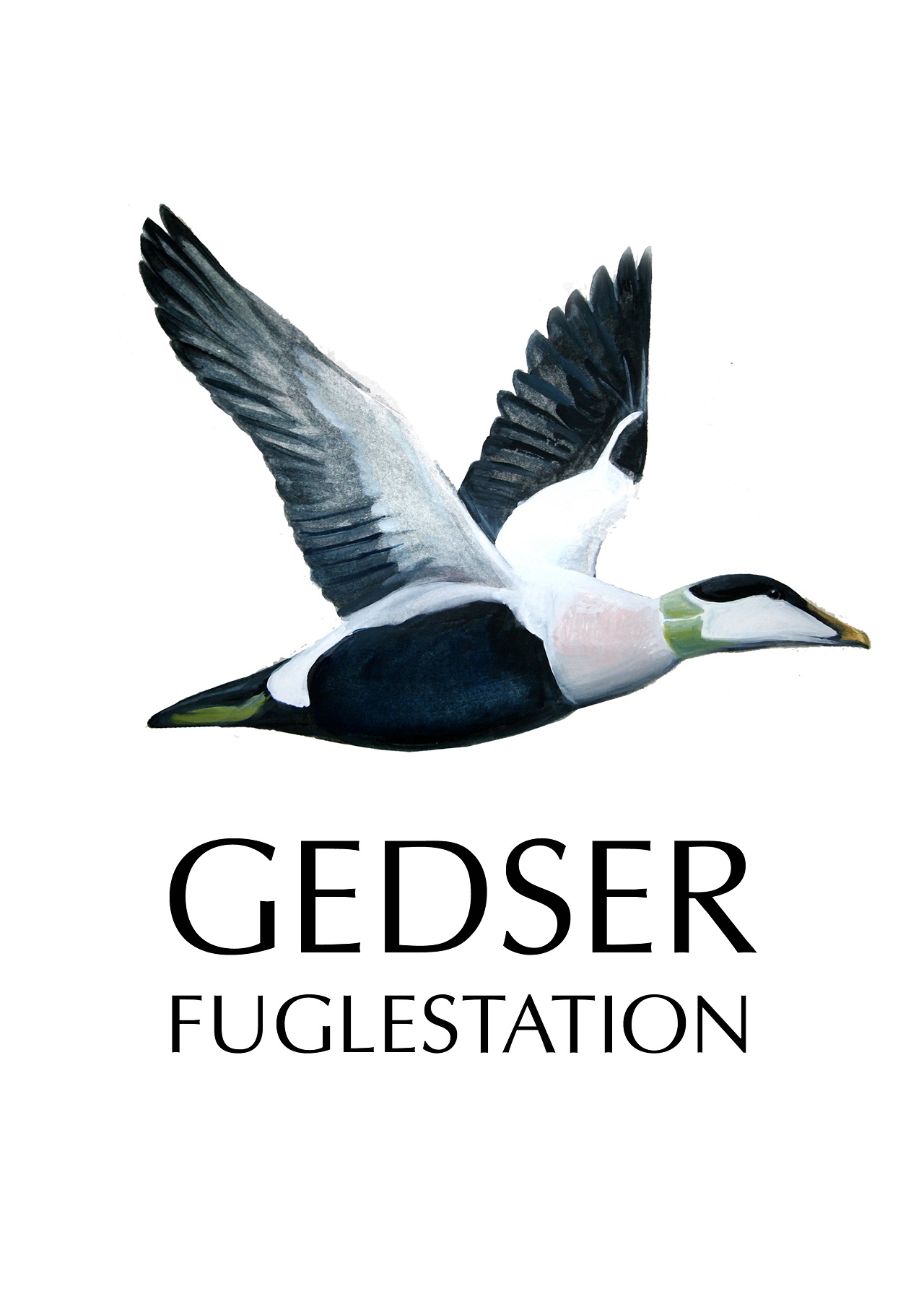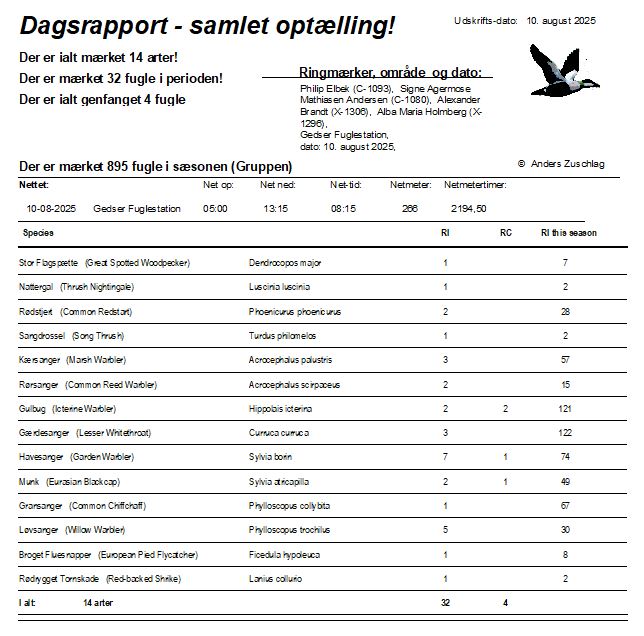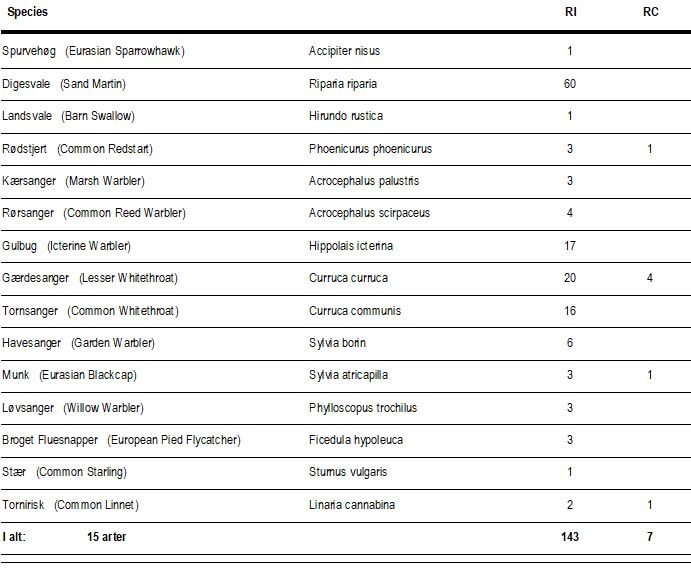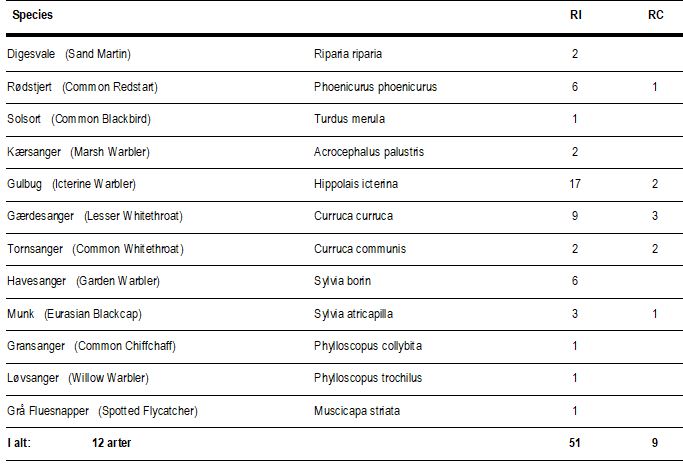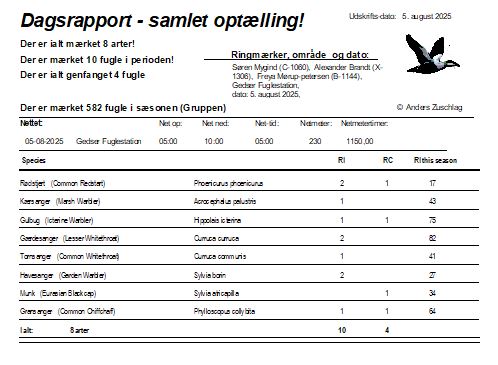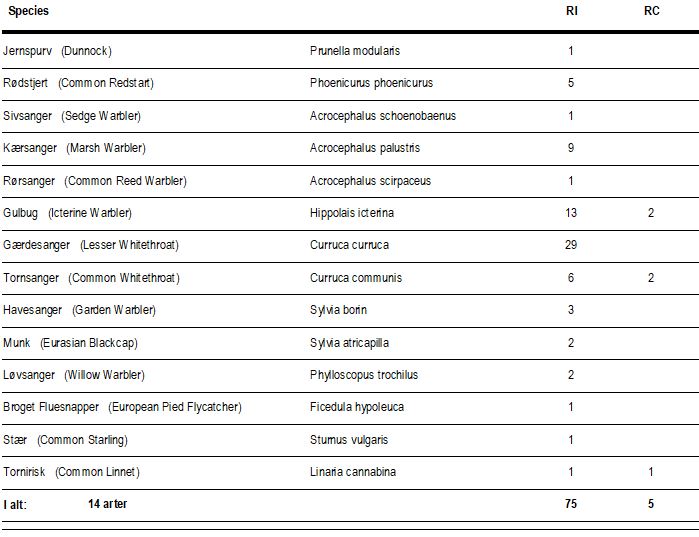Gedser Fuglestation Blog
Her på Gedser Fuglestations blog bringes korte nyheder i dagbogsformat om hændelser på fuglestationen.
Startskud på træktælling
Trækket på Odden: Mandag er første tælledag i vores standardiserede registrering af trækket på Gedser Odde i dette efterår. Derfor var vi to fra fuglestationen ude at se på trækket i fem timer søndag morgen for at få en ide om, hvad vi kan forvente og måske skulle hjem at genopfriske til bestemmelse af de arter, der vil komme. Senere fik vi selskab af Anders Zuschlag, som står bag det program, ringmærkerne bruger til at indtaste deres fugle i.
Vejret var smukt, og vi hyggede os især med at bestemme de terner, der trak forbi Odden. Det er der næsten altid udfordringer i. Terner kan være lette nok at bestemme tæt på og i godt medlys, men vi har modlys, og mange af ternerne ser vi på temmelig stor afstand ude over havet. Søndag så vi med sikkerhed en Sortterne (Chlidonias Niger)og en del Havterner (Sterna paradisea), som er i gang med et af verdens længste fugletræk, der vil føre dem til Antarktis, hvor de overvintrer.
Desuden var der Splitterner (Thalasseus sandvicensis), som starter trækket med at strejfe lidt omkring med ungerne til gode steder med mad, hvor de kan raste i flere dage. Ringmærkning har vist, at Splitterner fra ynglekolonier ved Vadehavet kan flyve op omkring Skagen og ind i Østersøen, før de for alvor trækker væk til de steder, hvor de overvintrer. Søndag talte vi lidt over 100 Splitterner, som fløj ind i Østersøen og lidt flere den anden vej. Det kan være fugle, der raster på Rødsand og fouragerer i området.
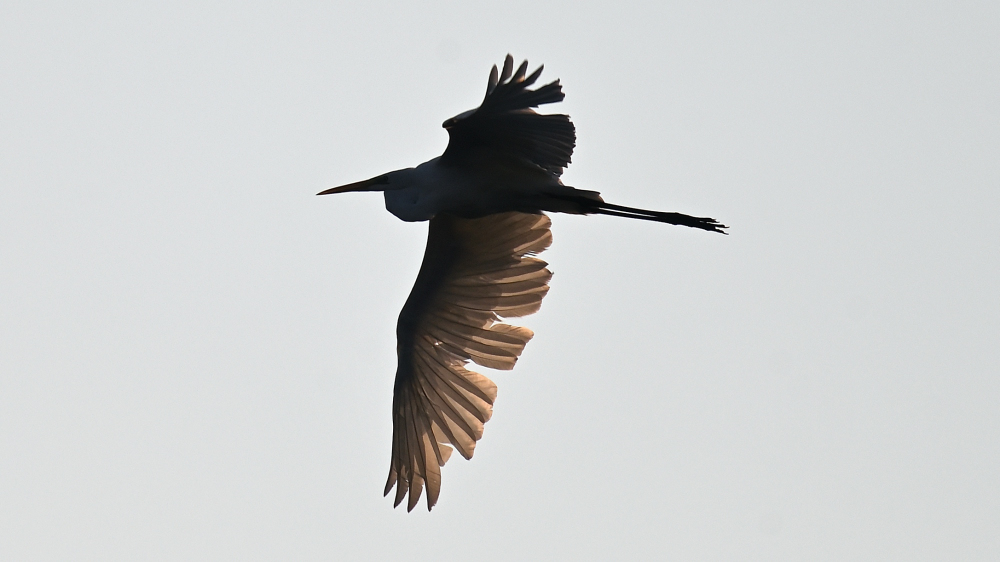
Bemærk, at man i denne tekst kan klikke på de tre arter af terner og på den måde komme til at læse mere om dem på DOF/BirdLife Danmarks netside om ’Danmarks Fugle’. Det vil vi gøre nogle gange i løbet af efteråret, men nu er tippet om et flot opslagsværk om fugle også givet, så man selv kan søge på de arter, man vil vide mere om.
Søndag blev det til 672 fugle fordelt på 20 arter. Det er nok nogenlunde det samme, vi kan forvente mandag. Et tilbageblik på, hvad vi har registreret i de fem standardtimer viser, at vi sidste år registrerede 899 fugle fordelt på 27 arter 11. august. I 2023 talte vi 1155 fugle fordelt på 34 arter, hvoraf 502 var Sortænder (Melanitta nigra), så et ryk af Sortænder kan ændre på det forventede træk mandag morgen. På træklokaliteten Põõsaspea neem i Estland så vores kolleger søndag over 16.000 Sortænder, så der er helt sikkert en masse på vej mod os.
Husk, at alle er velkomne til at komme og være med til at opleve trækket på hele Nordens sydligste punkt. Mandag starter tællingen klokken 5:09 og varer til 10:09. Vejret tegner til at starte lidt skyet, men med fuld sol fra klokken ni, og der kommer ingen vind.
Nyt fra stationen: Søndag var sidste dag for Alexander Brandt. Han har været med til at skabe en god sommertid for ringmærkningen ved Gedser Odde og lovede at komme igen. Inden han forlod stationen var han dog med ude til standard-ringmærkningen, som foregik fra kl. 5 til 10. Her var han til god hjælp for Philip Elbek og Alba Holmberg, som også ringmærkede om morgen, da han havde alle de kendetegn, der benyttes til at aldersbestemme de arter vi typisk fanger på Gedser for tiden, frisk i hukommelsen, og kunne derfor hjælpe med at få disse arter genopfrisket/lært på ny ret hurtigt.
Ringmærkningen: Selve ringmærkningen var meget stille og rolig. Der blæste en del, og som resultat heraf var der ikke specielt mange fugle i nettene, på trods af at vejret ellers var fint. Til gengæld var der en rigtig god artsdiversitet, hvor nogle af de tidligere to ugers store hit-arter blev fanget igen, såsom endnu en nattergal (Luscinia luscinia) og en fin ung rødrygget tornskade (Lanius collurio), som ikke bed nær så hårdt som de ellers plejer. Den mest talrige art var havesangeren (Sylvia borin), som vi fangede i alt 8 individer af.
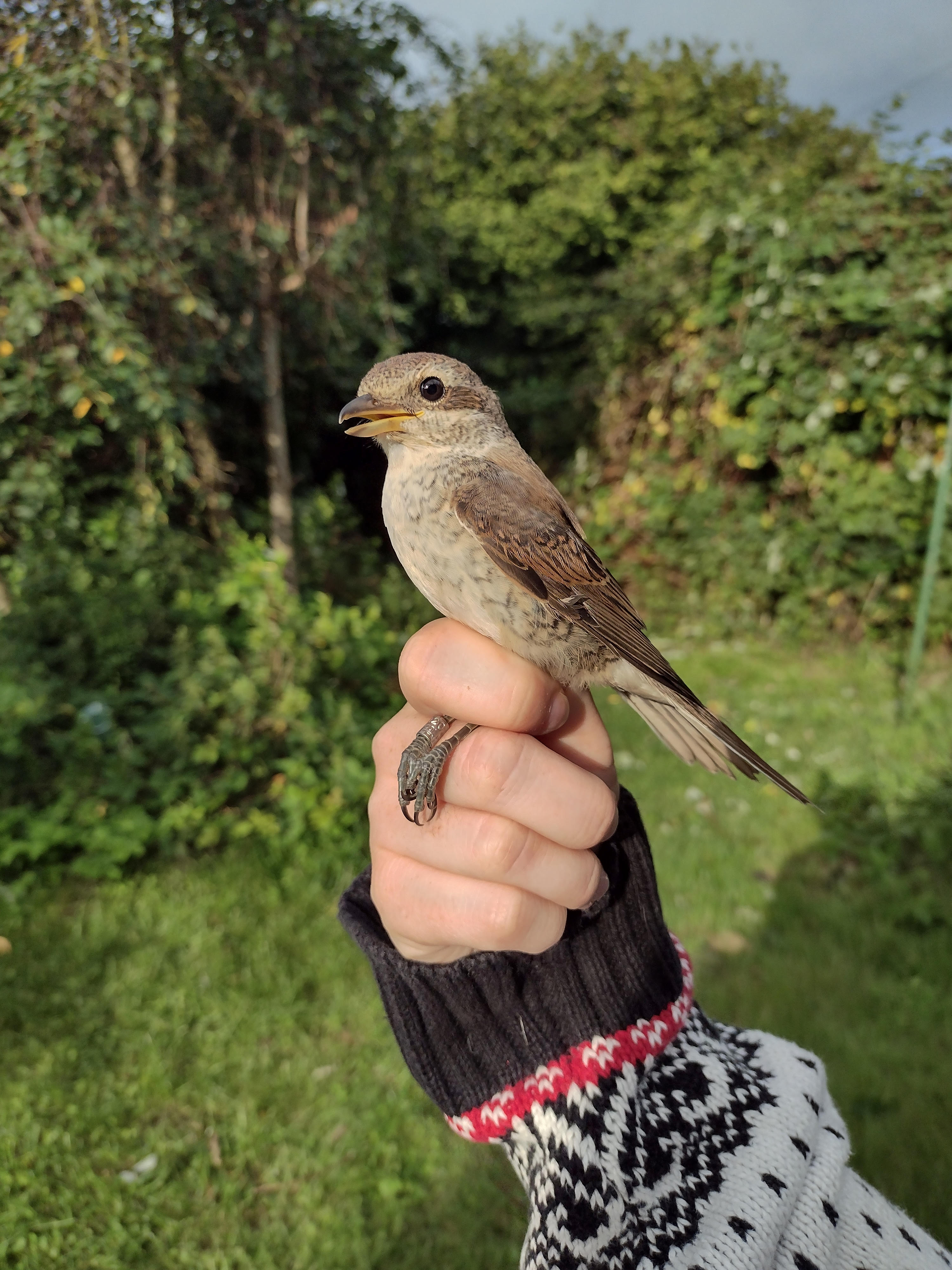
Den unge 1k rødrygget tornskade. Som kan ses på billedet, har denne art en spids krog for enden af næbbet, som de ofte bruger til at rive kød af deres bytte. Når man har en i hånden, forsøger de ofte at gøre det samme mod ens fingre, og de kan ofte få den til at bløde. Denne tornskade bed dog ikke så hårdt.
I alt blev det i dag til 32 ringmærkninger og 4 aflæsninger, fordelt på 14 arter.
Se alle dagens observationer fra Gedser Odde i DOFbasen.
Folk på stationen: Mads Elley, Alexander Brandt, Signe Agermose, Leander Agermose Elbek, Philip Elbek, Alba Maria Holmberg og Ole Friis Larsen.
Havedag, styregruppemøde og nye folk
Nyt fra stationen: Lørdag blev en travl dag med mange frivillige i aktivitet på fuglestationen. Styregruppen holdt møde om ideer og et oplæg til DOF/BirdLife Danmarks strategi for de næste år, og samtidig var der et godt fremmøde af folk til havearbejde om eftermiddagen.
Freya tog hjem efter en periode som ringmærker, da dagens standardtid var overstået. Trækket er ved at tage til, og der kom tre nye ringmærkere. Alba Maria Holmberg er ny i arbejdet på fuglestationen, men har erfaring fra ringmærkning på Rungstedlund i Nordsjælland. Hun kommer til at arbejde sammen med Signe Agermose og Philip Elbæk, der begge er kommet på fuglestationen som ringmærkere gennem flere år. Med Signe og Philip kom også Leander på halvandet år. Det er nyt for os, at folk tager deres børn med på jobbet på fuglestationen, men vi er glade for den udvikling. Det betyder, at vi ikke behøver at miste kontakten til dygtige unge ringmærkere og frivillige i det hele taget, når de bliver børnefamilier.
Se alle dagens observationer fra Gedser Odde i DOFbasen.
Folk på stationen: Bo Kayser, Tina Elley, Mads Elley, Søren Mygind, Gert Juul Jeppesen, Bo Kayser, Kenneth Rude, Anne Marie Reith, Alexander Brandt, Freya G. Mørup-Petersen, Ester Dalby Andersen, Per Sander, Poul Henriksen, Jan van Dijk, Signe Agermose, Alba Maria Holmberg, Leander Agermose Elbek, Philip Elbek og Ole Friis Larsen.
Sæsonens første spurvehøg!!
Dagen i dag bød på endnu mindre vind end i går og klar himmel, hvilket gjorde, at vi havde gode forventninger til dagen. Første runde havde en lille håndfuld fugle og anden runde havde også pænt, indtil vi nåede frem til det sidste net på runden, hvor der sad 17 fugle i - storset kun gulbug og gærdesanger. Jeg sagde til Alexander, at han skulle hente kasser i labbet, som han hurtigt gjorde og vi samlede alle fuglene i kasserne.
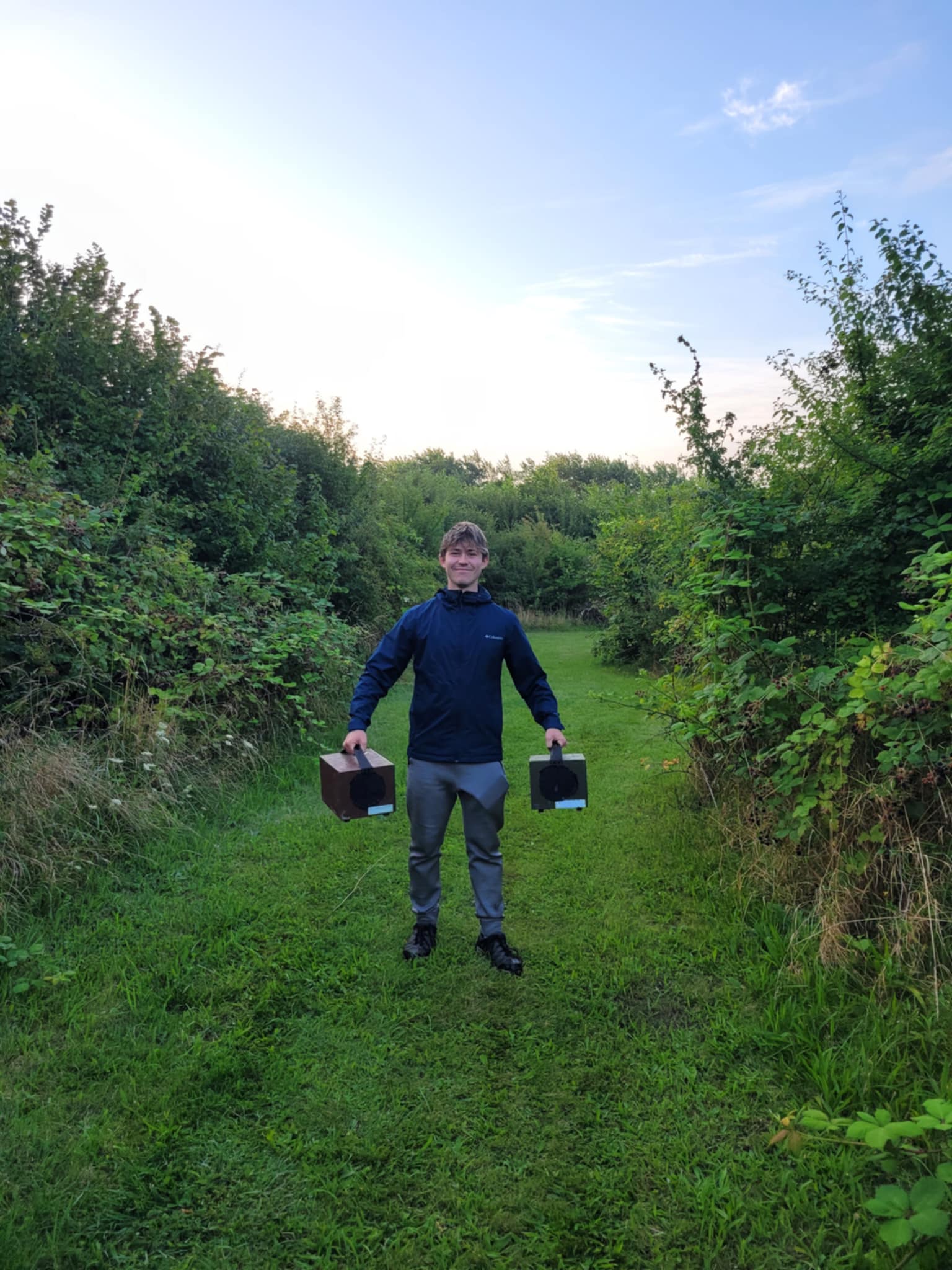
Alexander med to kasser til fugle. Kasserne er effektive til hurtigere håndtering når der er store tal af en art
Gulbuge og Gærdesangere dominerede klart standarden, men vi havde også tre Broget Fluesnapper. Efter endt standard havde vi stadig pænt med fugle i nettene, så vi besluttede os for at holde nogle af nettene åbne og samtidig åbne nettene ved søen i håb om svalefangst. Det gav i den grad bid! Luften var fuld af Digesvaler, som var meget interesseret i søen og vi fangede rigtig mange. Dagens højdepunkt var nok, at vi på en af runderne lige havde tømt sønettene for mere end tyve svaler og da vi gik ind i haven for at tjekke nettene der, sad der en Spurvehøg i det første net. Alexander løb hen og nåede at få fat i den, men ikke før den også fik fat i ham med sine skarpe kløer. Dermed fik Alexander sin første oplevelse med en rovfugl og også mærket sin og sæsonens første Spurvehøg.
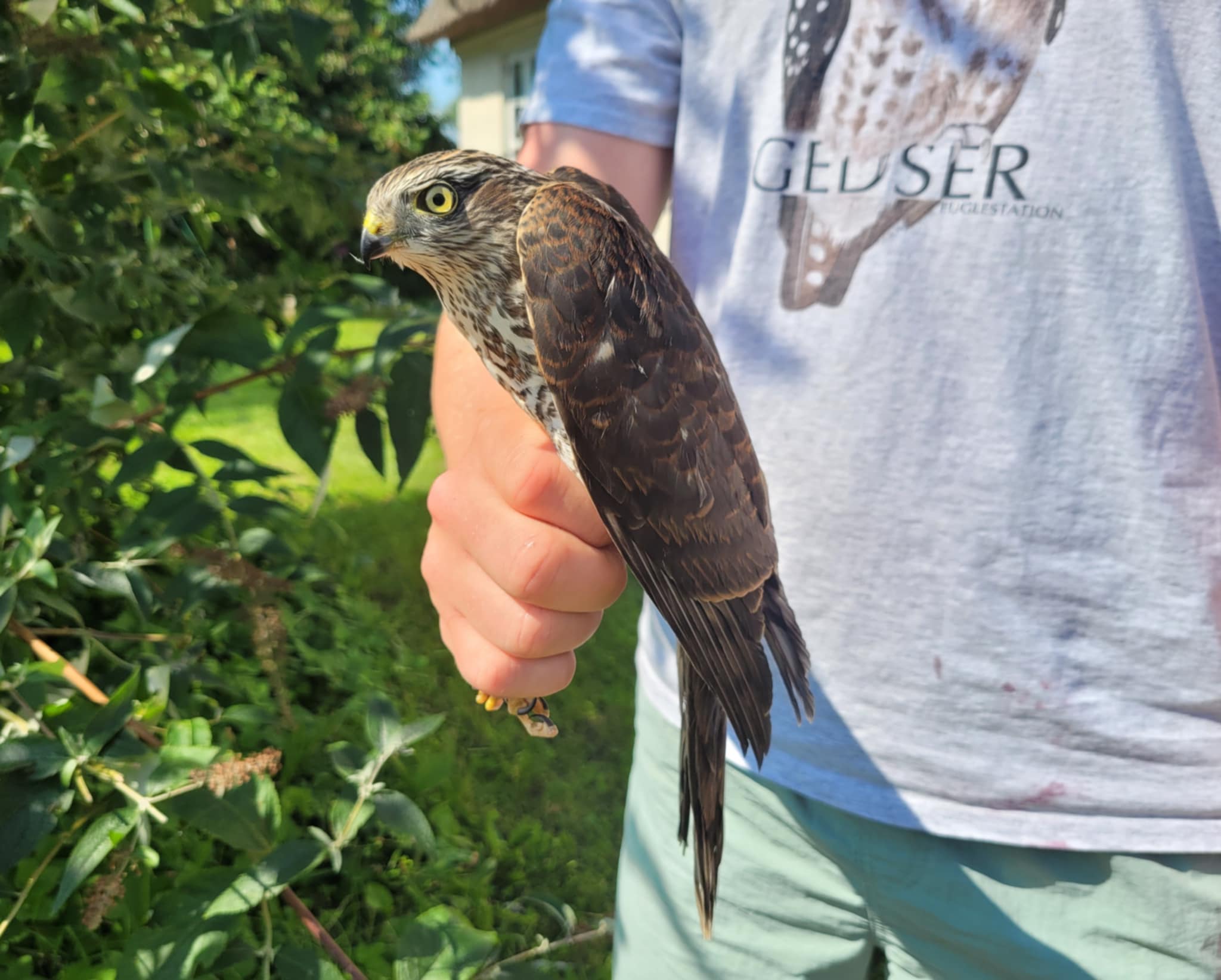
1k Spurvehøg han
Spurvehøgen var lille og chokoladebrun med lyse skælmønstre på kroppen og gule øjne, så vi bestemte den til at være en ung han. Efter lidt beundring og nogle fotos lod vi den flyve videre, hvor vi senere så den jage i haven. Ved 16-tiden lukkede vi nettene, ikke fordi der ikke var fugle, men fordi vi skulle nå at taste data ind og lave aftensmad - lækker hjemmelavet pizza!
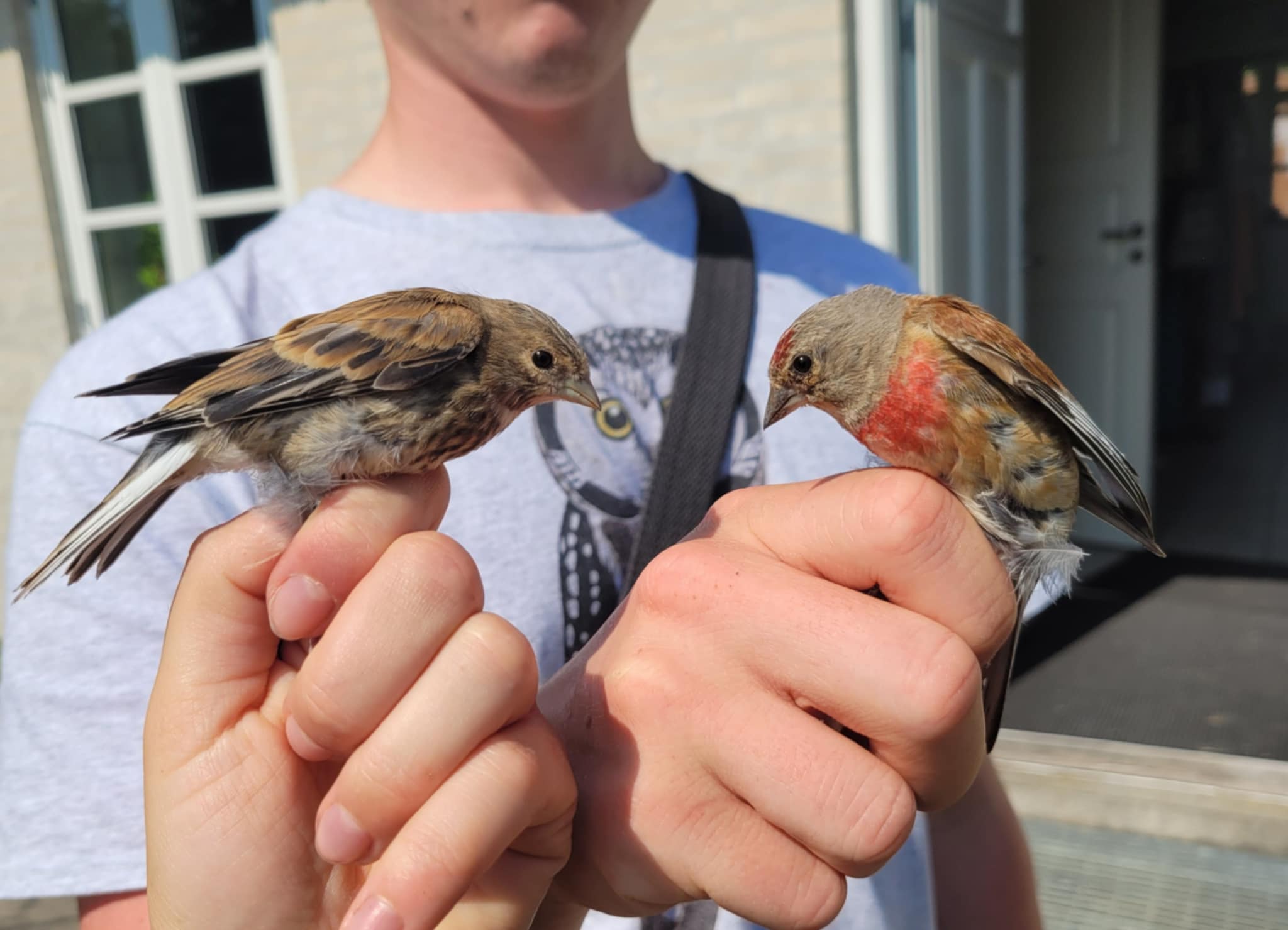
Tornirisk 1k og 2k+. Begge er hanner
Ole Friis kom også i eftermiddag og han skal stå for trækobs resten af sæsonen. Det er desuden min sidste aften på Gedser Fuglestation, da jeg rejser hjem i morgen efter standardmærkning. Det har som altid været et rigtig skønt ophold på fuglestationen med masser af fugleoplevelser!
Folk på stationen: Alexander Brandt, Freya G. Mørup-Petersen, Ole Friis Larsen
Solskin og gule sangere
Ja, endelig en rolig og rar morgen hvor alle ønskede net kunne åbnes. En stor kontrast til foregående dags 13 sekundmeter. Inden for de første par runder var det allerede tydeligt at der var godt gang i haven, og nogle arter blev tydeligt dominerende i nettene. Dog gav den første runde to arter vi ikke har så mange af, nemlig grå fluesnapper og solsort.
Gærdesangeren (Curruca Curruca) var stadig tydeligt i højt antal som andre dage, men i dag blev den ikke den mest talrige. Gulbugen (Hippolais Icterina) var der nemlig rigtig mange af, ja stort set ikke en eneste runde gik uden en eller flere gulbuge. Det blev altså tydeligt at gulbugens træk for alvor var gået i gang, mod Afrika.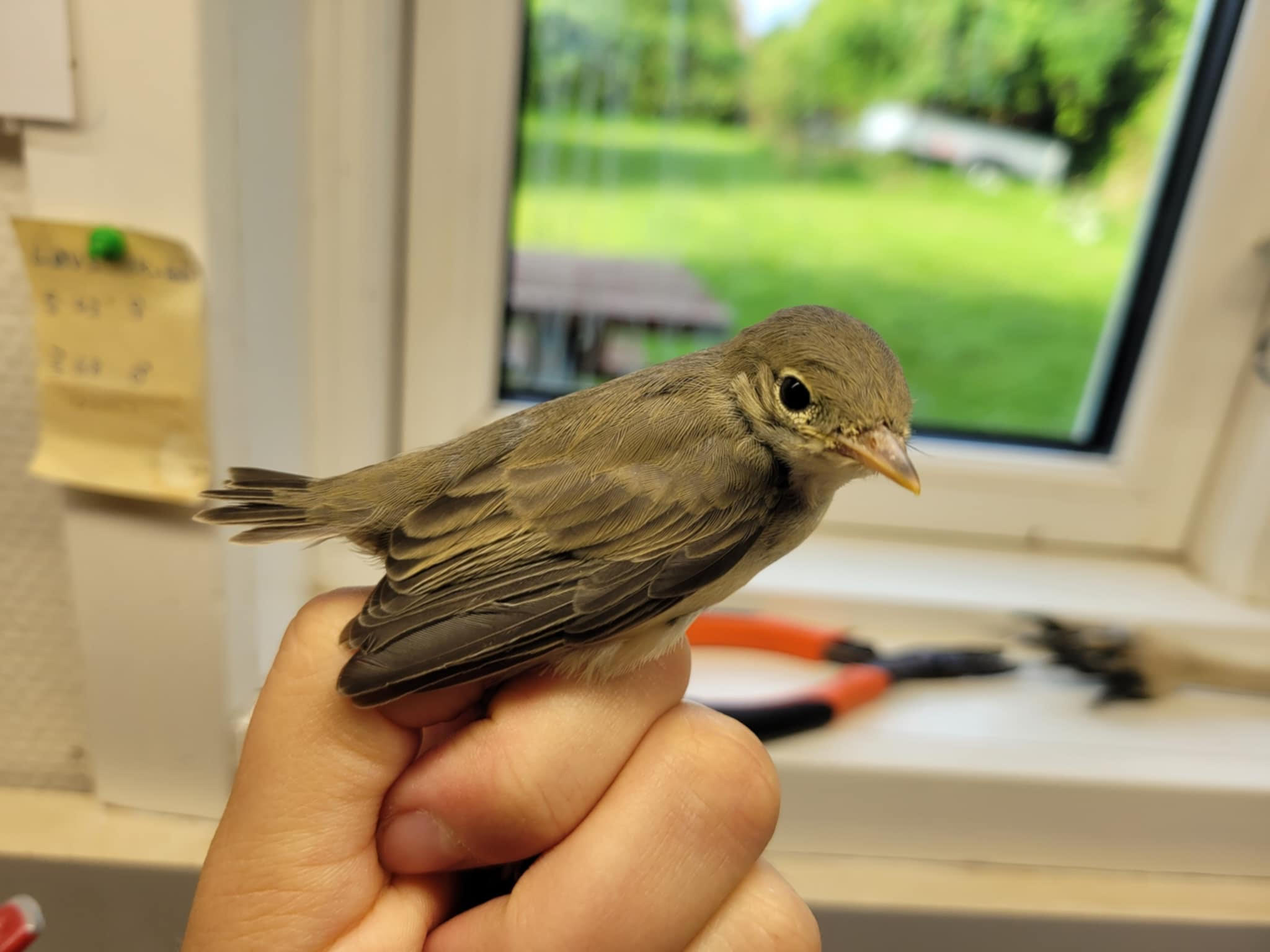
Gulbug 1k (Hippolais Icterina). Ofte bestemmes ungfugle af gulbug på deres tungepletter, og det kan være udfordrende at åbne munden på fugle for at tjekke sådanne detaljer. Dog hjælper det, at gulbugen larmer meget og mand derfor kan kigge ind i munden mens den skraber af dig. En anden god måde at bestemme alderen på, er hvor kraftigt gul, bugen er, da yngre fugle som oftest er mere blege. På dette billede har fuglen dog gjort det rigtig let for os, da den er helt ny ud fløjen fra reden og derfor har meget kort hale og vinger.
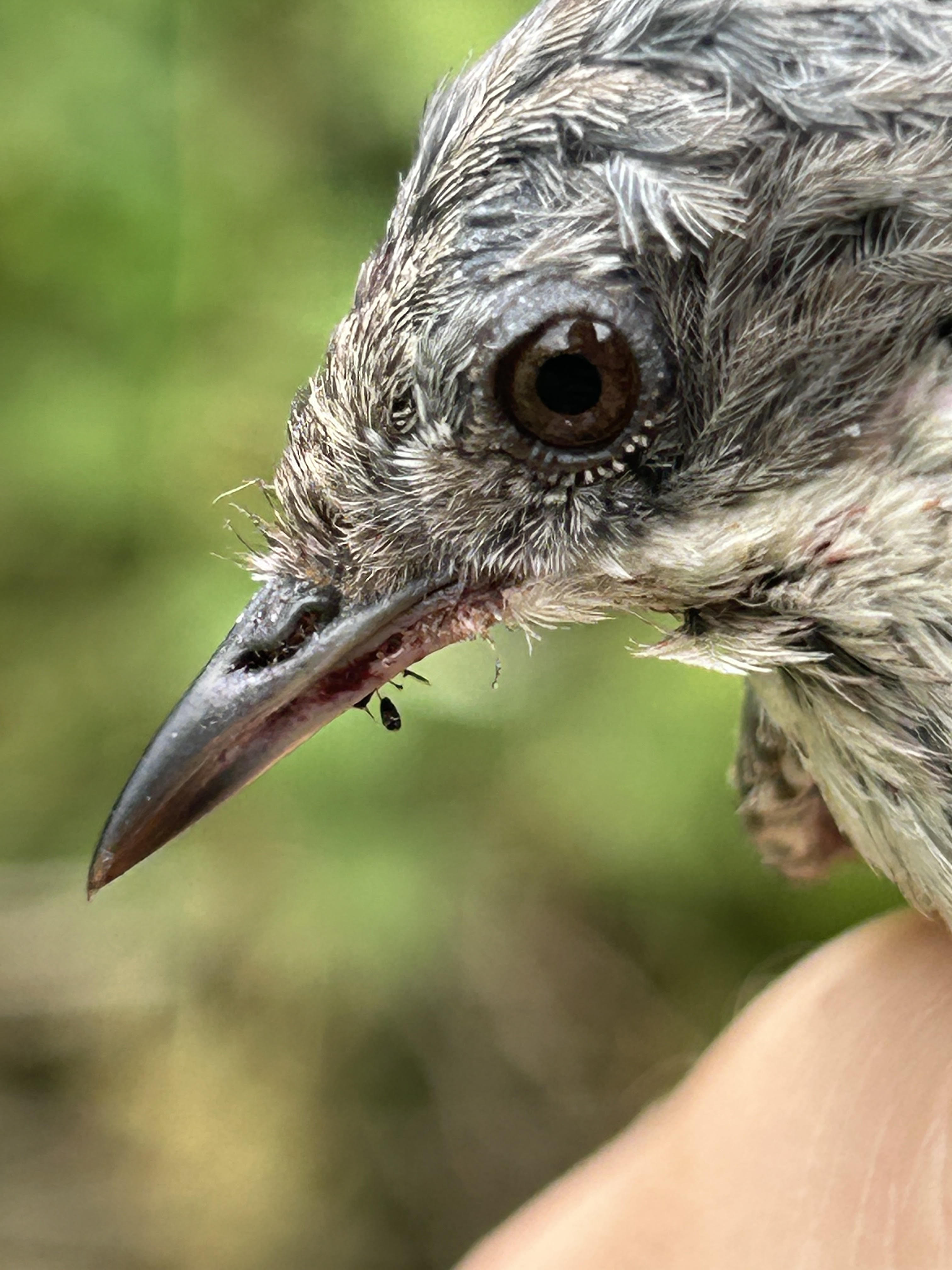
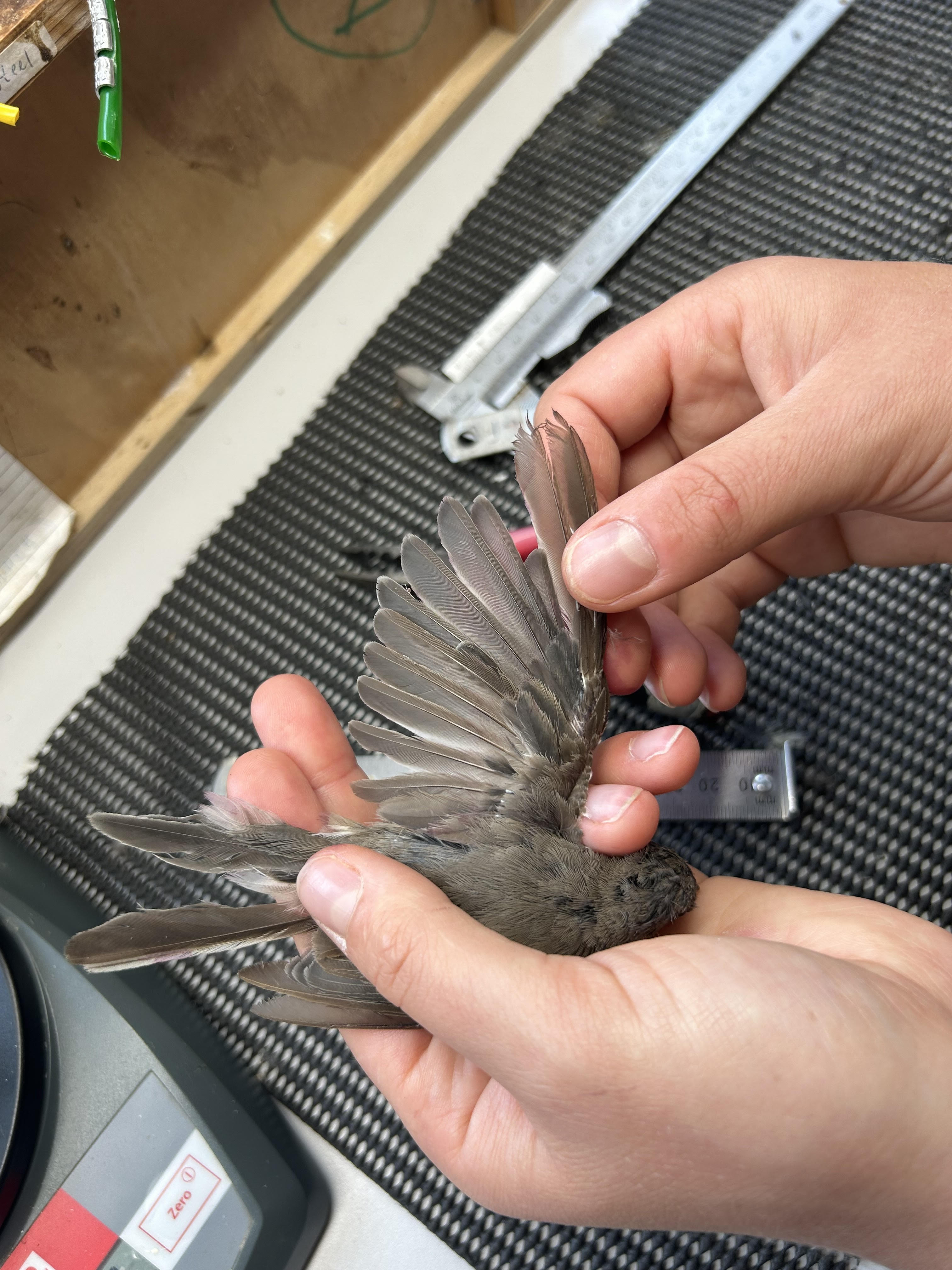
Gærdesanger 4k (Curruca Curruca). Vi fanger stadig mange gærdesangere der trækker for fuld knald lige nu. I dag var vi dog lidt ekstra heldige og fangede en gammel fugl med ring på i forvejen. Den kunne let bestemmes til 2k+ på både øjenfarve og den meget tydelige fældning af alle fjer. Det viste sig at denne fugl var ringmærket på stationen tilbage i 2023 som gammel fugl, og at den derfor lever sit fjerde år, hvilket er en god alder for sådan en lille fugl. Det er fantastisk at tænke på, at den ved egen kraft har taget turen til Afrika og tilbage 3 gange og gør sig klar til den fjerde, hvilket svarer til næsten 60.000 kilometers rejse.
En anden art vi ser ofte i haven, men sjældent i nettene er rødstjerten (Phoenicurus Phoenicurus), og den var vi så heldige at fange 7 af i dag, hvilket blev den tredje mest talrige for dagen. De smukke fugle kan dog være svære at bestemme alder på da hunner og ungfugle let forveksles, og det krævede omhyggelig undersøgelse af eksempelvis fældning i vingerne, for at bestemme både køn og alder.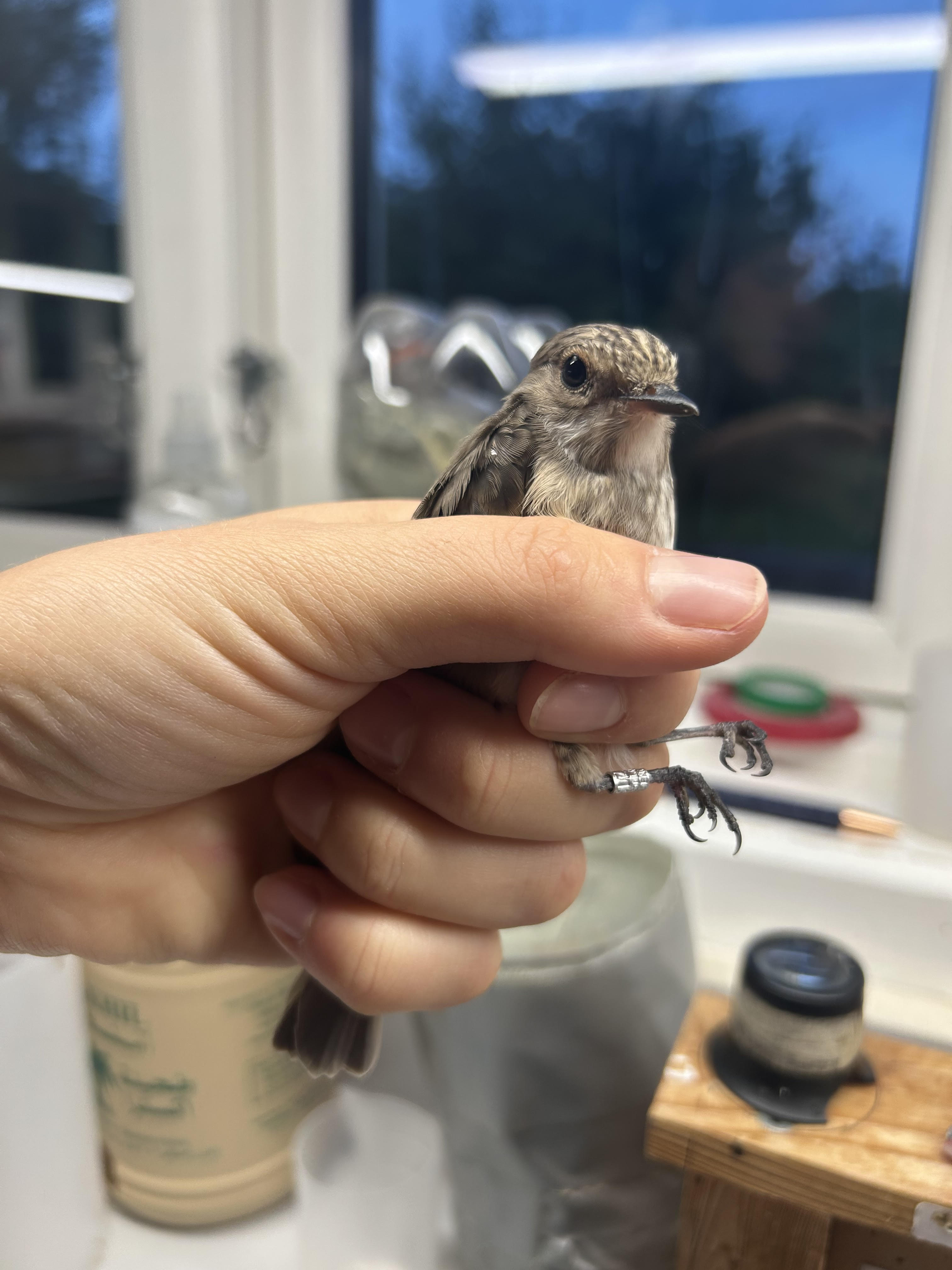
Grå fluesnapper (Muscicapa Striata) 1k+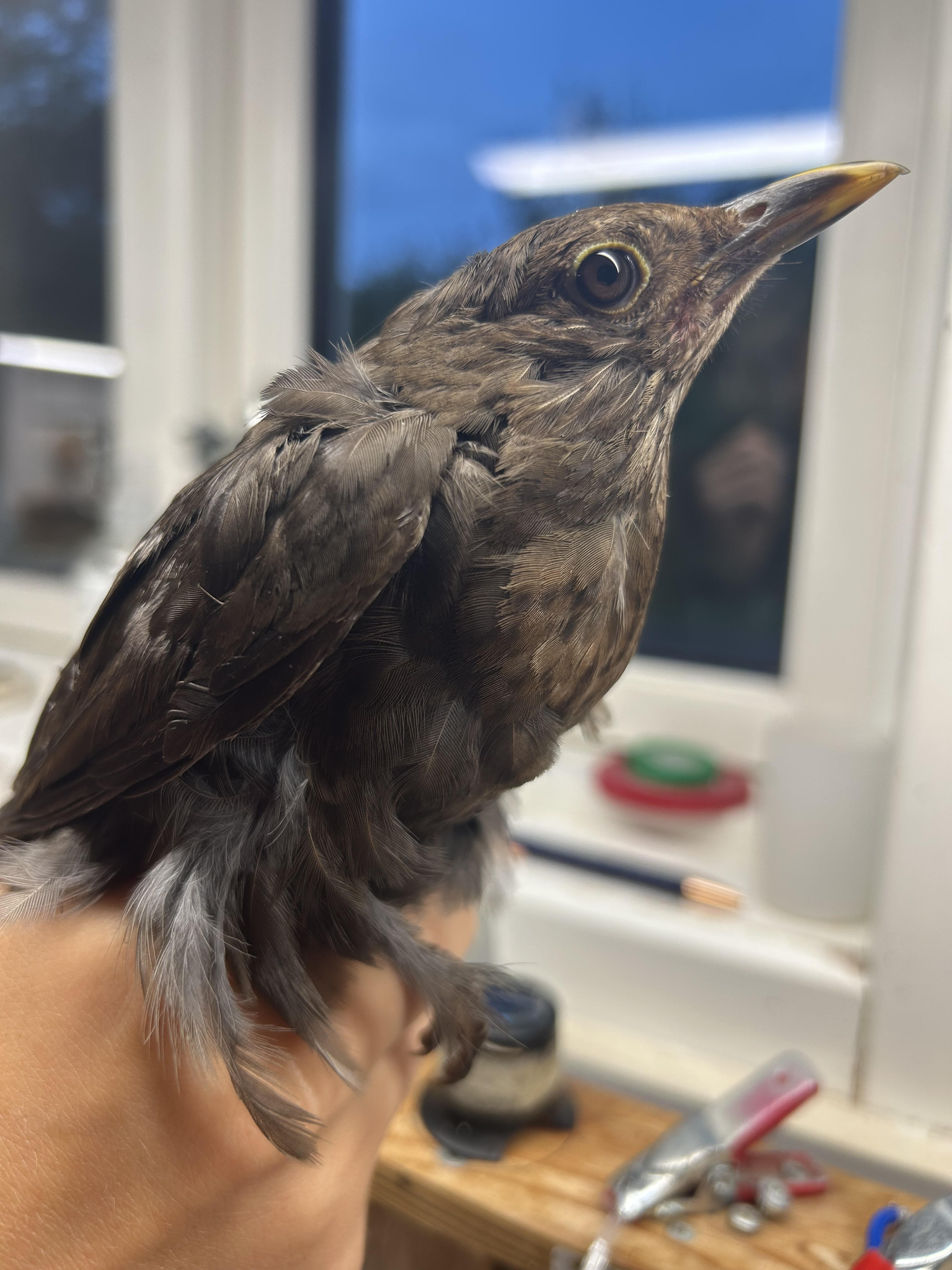
Solsort (Turdus Merula)2k+ hun
På stationen: Freya Mørup petersen og Alexander Brandt
Heftig vind i sejlene
Vinden har været noget kraftig de sidste par dage, men vi vidste allerede i går aftes at i dag ville den blive endnu kraftigere - med middelvind næsten helt op til 13 m/s fra vest. Det er slet ikke godt ringmærkervejr, da kraftig vind gør nettene synlige og generelt får fuglene til at trykke sig i buskene. Men Alexander og jeg stod alligevel op ved 4-tiden og gik ud for at finde de net i haven, der stod i læ. Nok net kom op til at kunne køre en standard, men vi måtte erkende, at dagen næppe ville byde på de store fangstantal - det er nok et vejr, der er mere givende for trækobservation!
Vi fik dog fugle fanget i dag, men ikke noget, der slår rekorder og mellem runderne, kunne Alexander stå og lave havobs fra engen, hvor han så sortterner, almindelig kjove og en enkelt sule. Dagens højdepunkt var nok en stor flagspætte, der dukkede op i nettet klokken 9 - det er nu alligevel en lidt sjov fangst på en ellers stille dag.
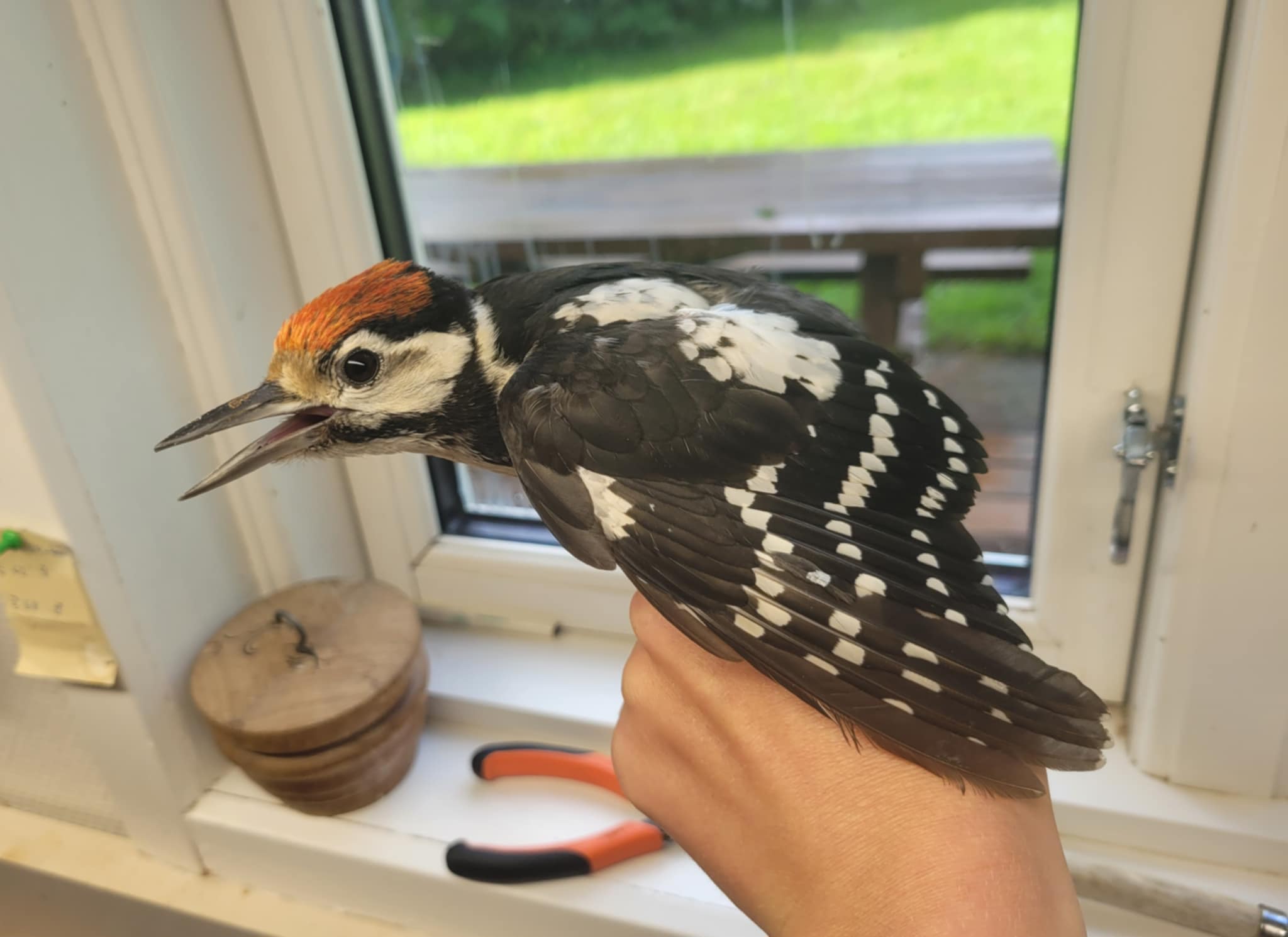
1k Stor Flagspætte
Efter standard lukkede vi, men åbnede dog enkelte net efter frokost, da vejret blev lidt bedre, men stadig med kraftig vind. Det gav blot to ekstra fugle, men det var også alt. Ellers gik vi rundt i haven og klippede brombærgrene væk, som var ved at blokere stierne eller netbanerne. Her fandt vi også flere kæmpestøvbolde i haven på størrelse med fodbolde.
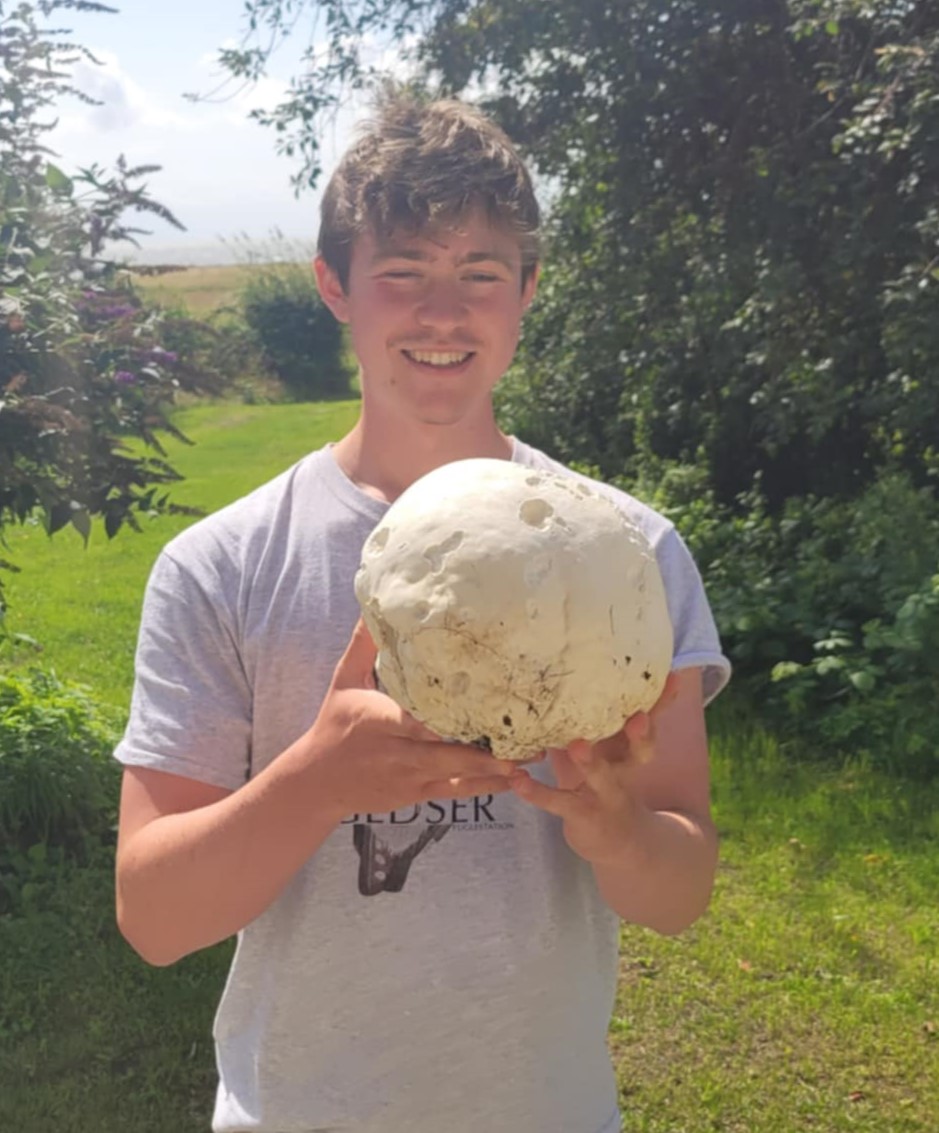
Alexander med en kæmpestøvbold
De fleste var desværre for gamle, men en var endnu helt frisk og den har vi har tænkt os at lave en svamperisotto med en af dagene. På en ringmærkermæssigt stille dag som denne, lærer man også at sætte pris på de små glæder.
Dagens fangster/genfangster
Stor Flagspætte (Great Spotted Woodpecker) 1/0
Gulbug (Icterine Warbler) 4/0
Gærdesanger (Lesser Whitethroat) 1/0
Havesanger (Garden Warbler) 0/2
I alt 6/2
Folk på stationen: Freya G. Mørup-Petersen, Alexander Brandt
Farvel og tak for denne gang
Så er min ophold på Gedser Fuglestation fobi for denne gang og det absolut sidste jeg gør efter at have støvet af, støvsuget og vasket gulv er at skrive denne blog.
I forhold til sidste år har jeg mærket lang færre fugle i år end sidste år, hvilket skyldtes at vi i år har været flere ringmærker på stationen og at der på grund af et vejr præget af lavtrykspassager, nedbør og blæst ikke har været så mange fugle at mærke i standardtiden, som har min første prioritet.
Til gengæld har det været en stor fornøjelse at mærke sammen med Alexander og Freya og mærke den entusiasme der kendetegner de to, der også er aktive i DOF ung. Imponerende og glædeligt at høre dem fortælle om, at de kan samle 45 deltagere på en lejer med DOF ung. Og endnu mere glædeligt at de er begyndt at mærke at Ørneklubben forsyner dem med nye medlemmer. Det lover godt for fugle sagen, fletornitologien og ringmærkning i fremtiden. Så mange tak for den oplevelse herfra.
Udover Alexander og Freya har Mette været her i perioden og blevet oplært i ringmærkningen. Mette er også aktiv ved Rungsted Lund CES site. Dejligt at vi kan være med til at støtte arbejdet på Rungsted Lund på denne måde. Og endelig var der besøget af den lille familie med Freja, Heidi og Boris, der jo fik en nærmere omtale blogen fra den 25 juli. Endeligt var Louis på besøg i går og det er jo altid spænende at snakke med Louis og hører om hans mange erfaringer med fuglestationsarbejde og feltornitologi.
I dag blev jeg samtidigt færdig med SU beskrivelse af den Ørnevåge, som kom forbi stationen d. 28 juli. Så med orden i papirarbejdet og med huset rengjort vil jeg glad tage hjem fra Gedser Fuglestation.
Farvel og tak fra denne gang og på gensyn i uge 42.
På stationen: Alexander Brandt og Freya G. Mørup-Petersen
Svalerne redder dagen
Meget få fugle var der i standarden. Med en lav artsdiversitet gjorde det, det ikke meget bedre, men en enkelt mindeværdig fugl fik vi hvilket var en meget stor havesanger. Som oftest vil fuglene havde høj fedtprocent på denne tid da de snart skal trække lange distancer uden mulighed for stop for at tanke op. Dette dokumenteres også under ringmærkningen, og fedtet noteres på en skala fra 1 til 9. Ved at puste på brystet af fuglene kan det lade sig gøre at se fedtet og organerne gennem huden, og ud fra illustrationer vurderes det så hvor fuglen ligger på skalaen. Havesangeren fra i dag fik en fedtscore på 8, hvilket ingen af os stort set har set før, med så høj en fedtprocent var kun lidt bryst synligt under det tykke lag fedt, og fuglen vejede langt mere end sædvanligt.
Med lidt andre fugle inden for standarden så det ud til at blive en trist dag, men pludselig slog solen igennem og vinden lagde sig meget betydeligt. Freya og jeg besluttede os for at svalefangst kunne blive rigtig godt, og vi åbnede derved nettene ved søen i håbet om at svalerne ville søge til søen, for at drikke. Dog havde vi aldrig set det komme, at vi ingen pauser kunne få for de kæmpe antal svaler der gik i nettene. Inden for nogle timer havde vi sat ring på hele 60 digesvaler (Riparia Riparia), og dermed tredoblet antallet af ringmærkede digesvaler her i efterårssæsonen. Det var tydeligt at næsten alle fugle der gik i nettene var ungfugle, og man kunne på mange af svalerne næsten vurdere hvor vidt de var fra første eller andet kuld i år. Med kun en adult digesvale, gav vi os god tid til at studere dragtdetaljerne.
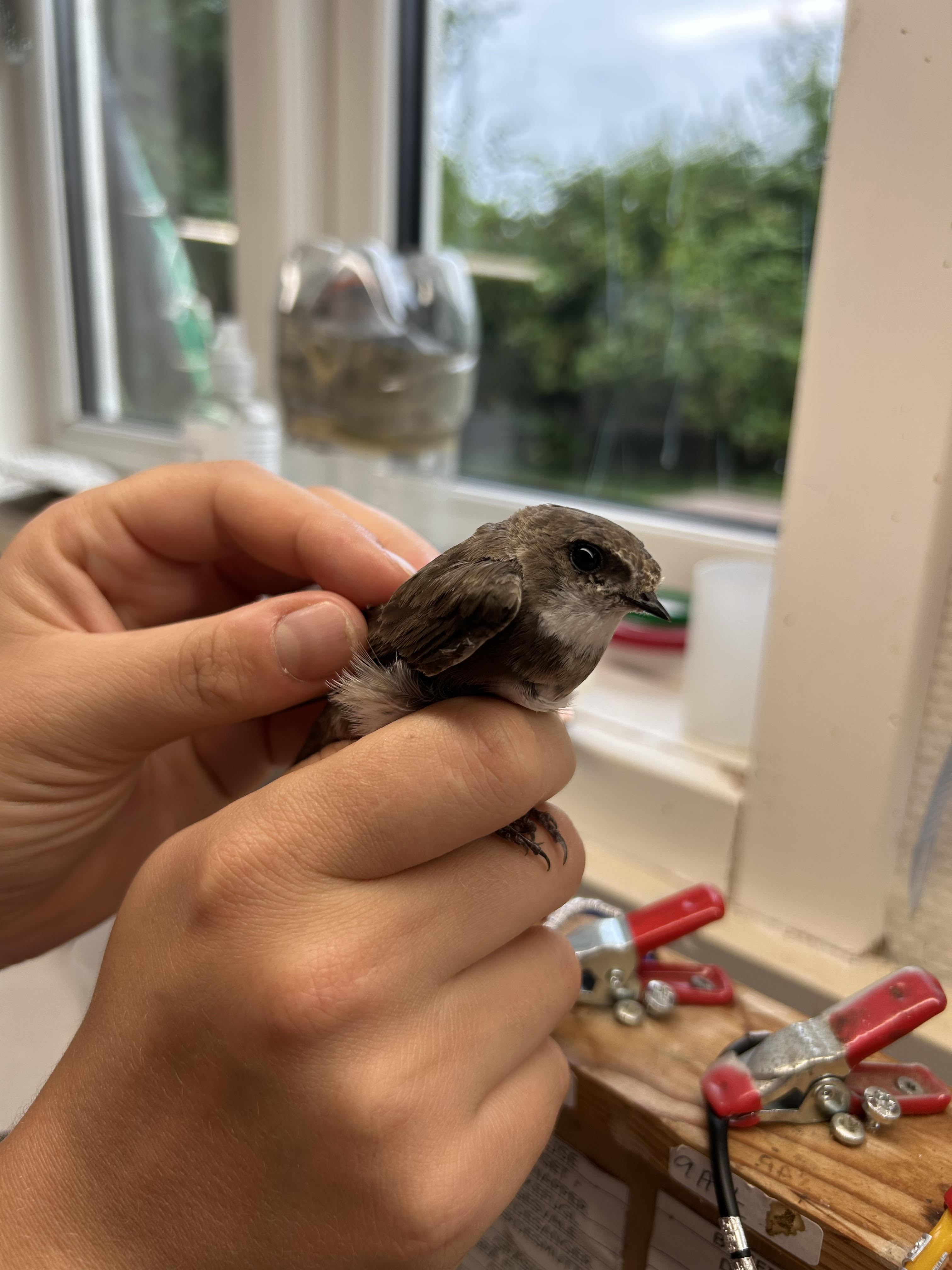
Digesvale (Riparia Riparia) 2k+. den eneste gamle fugl i dag. Kan især kendes fra ungfugle på den rene brungrå overside i modsætning til de lysskællede unge svaler.
Dagens fangster/genaflæsninger
Digesvale (Sand Martin) 60/0
Rødstjert (Redstart) 1/1
Kærsanger (Marsh Warbler) 0/1
Gulbug (Icterine Warbler) 5/3
Gærdesanger (Lesser Whitethroat) 3/1
Tornsanger (Whitethroat) 4/0
Havesanger (Garden Warbler) 2/0
Munk (Blackcap) 2/0
Musvit (Great Tit) 0/1
Tornirisk (Linnet) 1/1
I alt 78/8
Folk på stationen: Søren Mygind, Alexander Brandt, Freya G. Mørup-Petersen
Regn og besøg hos familien svale
Da vi stod op, varslede vejrudsigten regn klokken 5, hvilket gjorde, at vi stod og var i tvivl, om vi skulle åbne net eller ej. Der gik lidt tid, hvor ingen vidste, hvorvidt vi skulle gå tilbage og sove eller gå ud i det regnfulde blæsevejr og åbne net, kiggede jeg på kortidsradaren, hvor der ikke var noget regn og tog beslutningen om at gå ud og åbne.
Regnen kom heldigvis ikke, men vejret var ikke særlig opmundrende. Det mindede om en efterårsdag med tunge skyer, dårligt sigt og kraftig vind, hvilket kunne give lidt fugle hvis det var oktober, men ikke august. Derfor var vi godt klar over, at det ikke ville blive en travl dag. Første runde meldte sig uden fugle, men heldigvis havde anden runde tre fugle, og sådan forsatte det med lidt fugle på hver runde, heriblandt en fin husrødstjert, som Alexander ringmærkede.
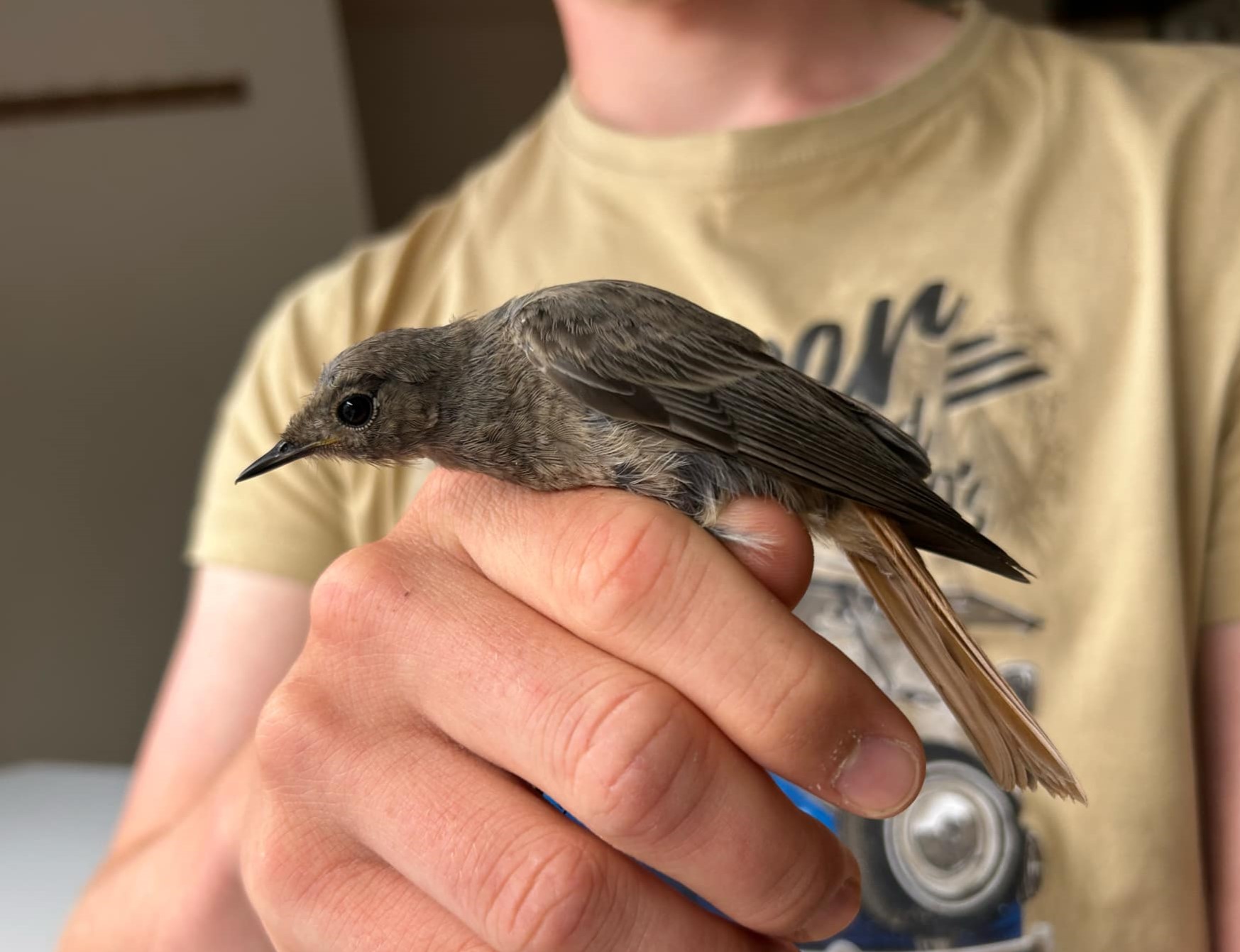
1k Husrødstjert. Bemærk den ensartede, grå bug, i modsætning til Rødstjert som har en rustrød bug. Foto: Alexander Brandt
Standarden sluttede og da de sidste par runder tomme, vinden havde taget til, samtidig med kanten af regnfronten lige havde nået Gedser, så vi besluttede os for at lukke. Søren kørte mod nord og Alexander og jeg tog hjem til Gert, som havde en landsvalerede på sit hus. Det var nu silende regn, men heldigvis kunne vi stå i læ under Gerts garage. Fire tykke landsvaleunger blev ringmærket, hvorefter de forsigtigt blev lagt op i reden igen. Så lidt kom der da ud af dagen, på trods af de noget dystre vejrforhold.
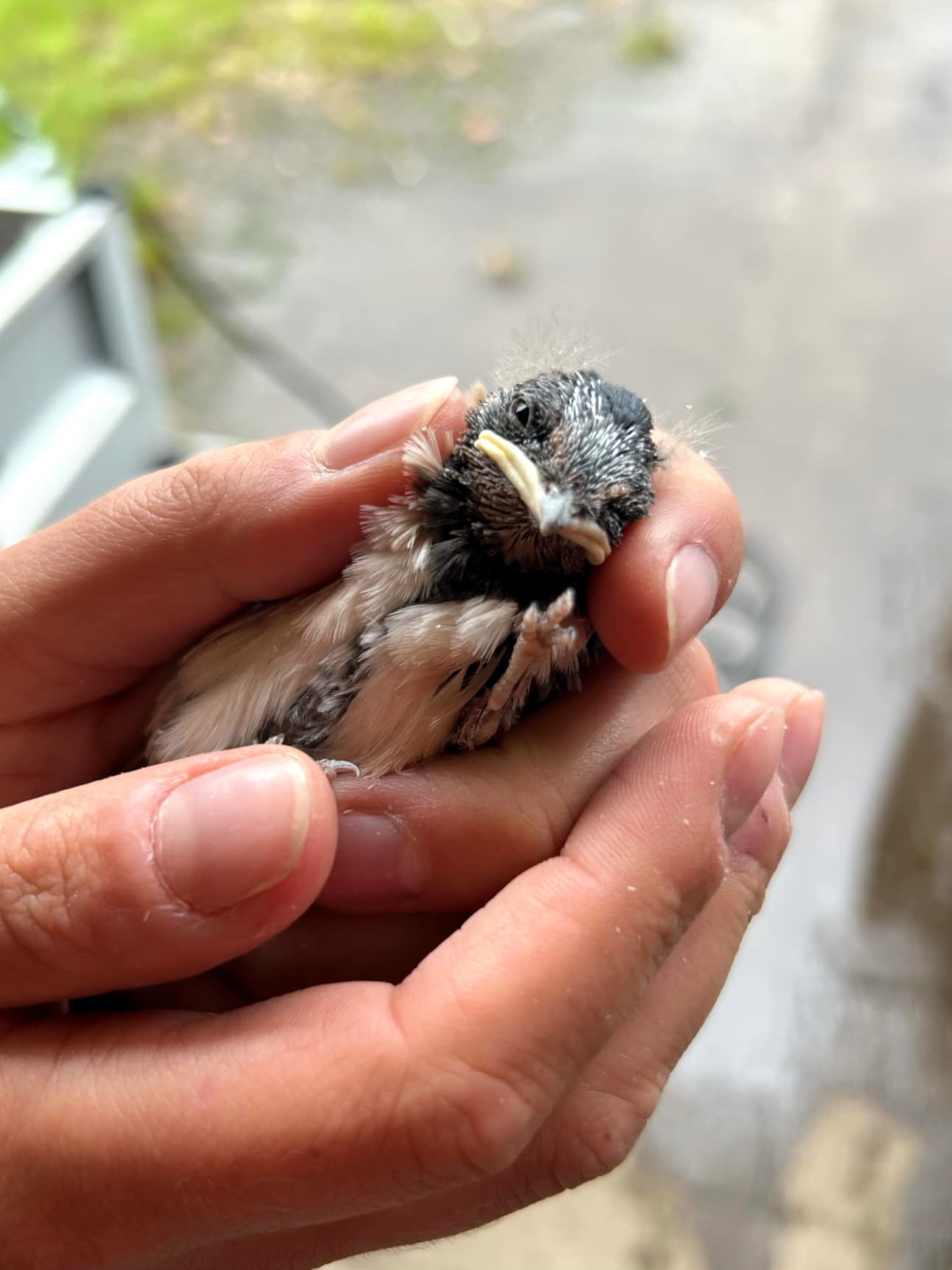
Landsvaleunge - om mindre end en måned er den og dens tre søskende trukket mod Afrika. Foto: Alexander Brandt
Dagens fangster/genfangster
Husrødstjert (Black Redstart) 1/0
Gærdesanger (Lesser Whitethroat) 3/0
Havesanger (Garden Warbler) 1/0
Munk (Blackcap) 1/0
Gransanger (Chiffchaff) 1/0
I alt 9/0
Folk på stationen: Søren Mygind, Alexander Brandt, Freya G. Mørup-Petersen
X-mærkerens manddomsprøve
De første runder foregik stille og der var tid til både at fordybe sig i detaljer samt at formidle ringmærkning til de mange hold af gæster der besøgte stationen på den dejligt solrige dag.
Dog skulle stilheden ikke vare for på runde nummer tre fik både jeg og Freya en overraskelse i et af nettene nært huset. Fuglen så større ud en de andre men den var godt bundet ind i nettet, så først da jeg kigger ned i netposen indser jeg hvad vi har med at gøre. ”Hov, en rødrygget tornskade”! En fin overraskelse med den første rødryggede tornskade (Lanius Collurio) i efterårs sæsonen og min første tornskade nogensinde.
Med det samme som jeg rør fuglen begynder den både at skrige og bide. Det blev mig en overraskelse hvor hårdt fugle kan bide, men Freya sagde til mig, at det ikke var noget jeg ville kunne undgå, og at jeg bare måtte bide det i mig. Efter en del kamp fik jeg pillet den finde unge tornskade ud og den blev taget ned til laboratoriet, så gæsterne kunne få lov til at se mig kæmpe videre med fuglen, men denne gang i hånden. 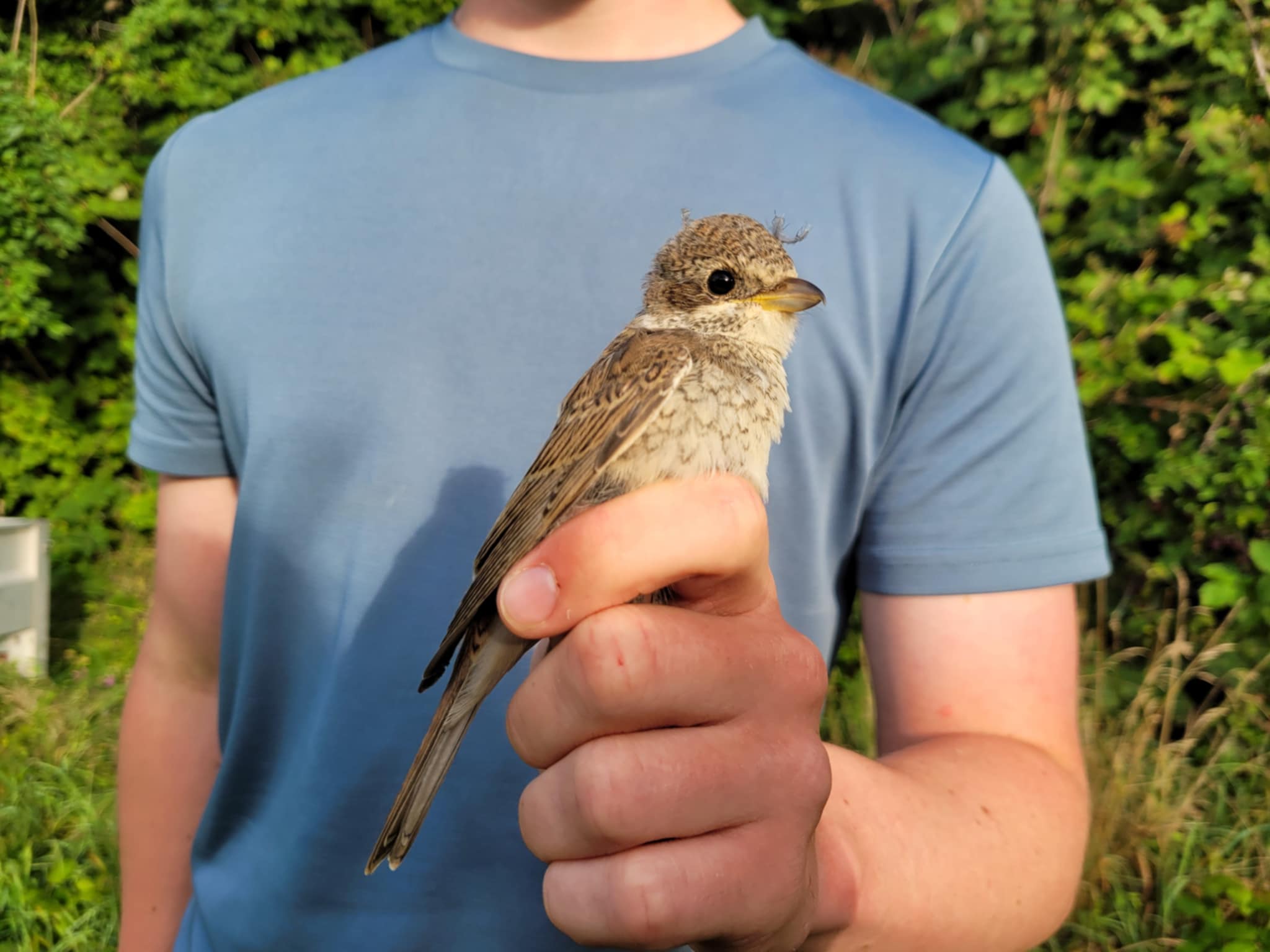
Rødrygget tornskade (Lanius Collurio) 1k. Kan forveksles med hunfugle, men er kraftigt spraglet og især dækfjerene på vingerne skal være helt ensfarvede på gamle hunner.
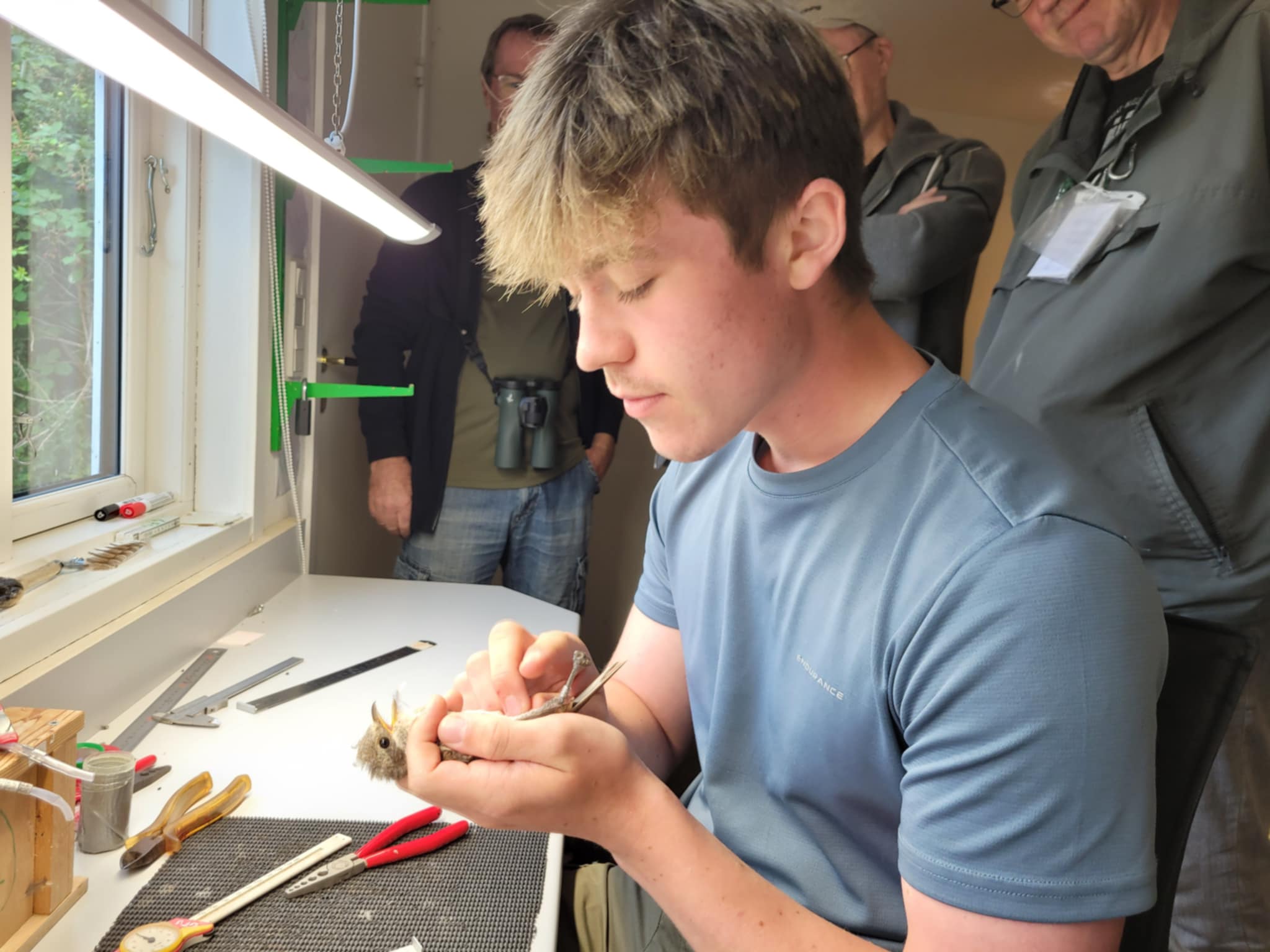
De rødryggede tornskader er en af de fugle hvor det kræver en stålring i stedet for aluminium. Dette skyldes deres meget kraftige næb, der bruges til at flå mindre bytte i stykker.
Efter mange stille runder uden det store dukkede svalerne pludseligt op på himlen, og Freya og jeg besluttede os for at sætte net op ved søen. Det gav bingo. Ikke mindre en 26 digesvaler (Riparia Riparia) samt en enkelt landsvale (Hirundo Rustica) gik i nettet, efter at havde gynget på det løse net og fået overbalance, og hver og en var ungfugle (1k).
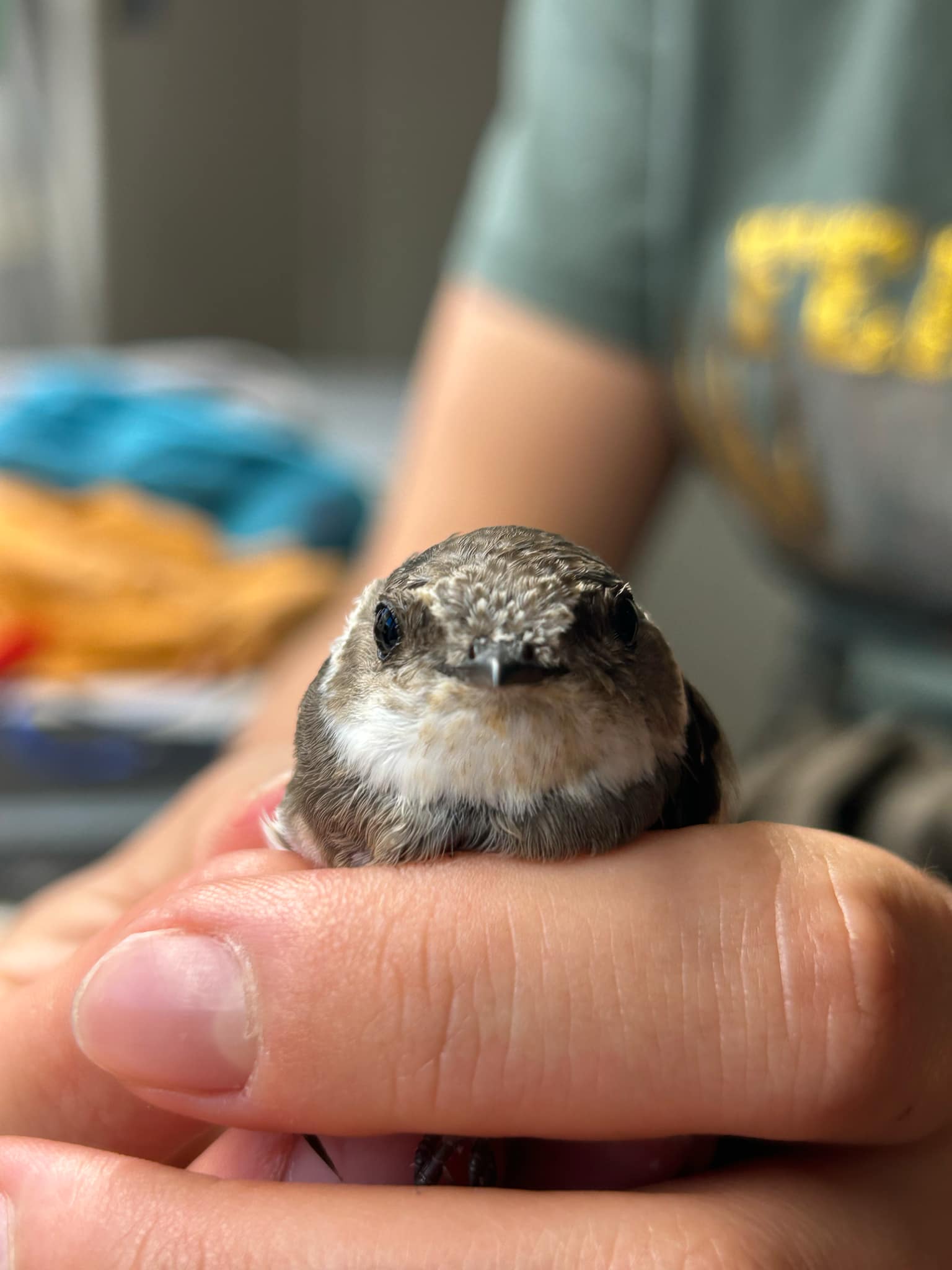
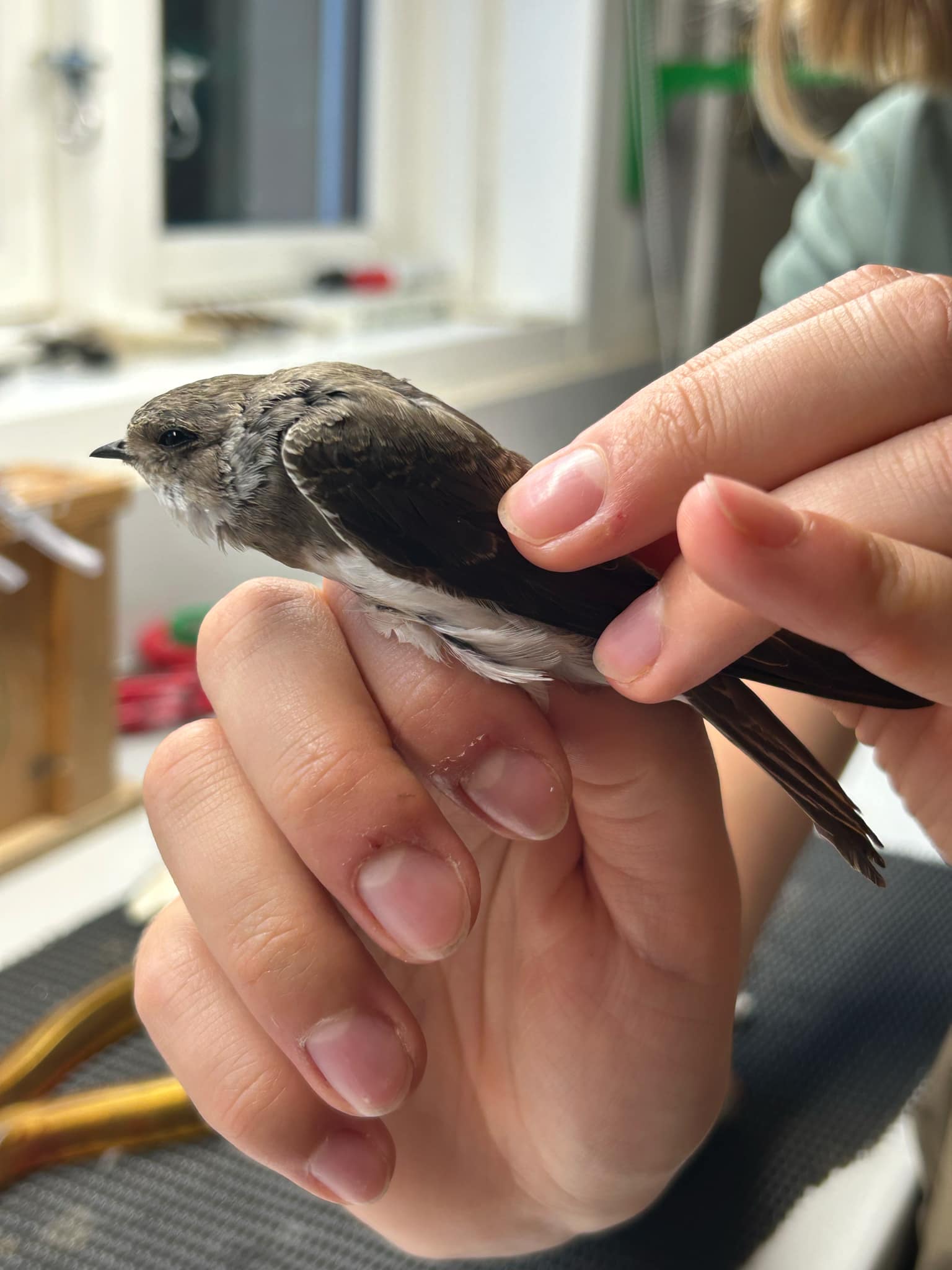
Digesvale (Riparia Riparia) 1k. Nok en af de mest rolige samt bedårende fugle at havde i hånden. Med deres meget små og skrøbelige ben er det vigtigt at holde hånd over de meget lange vinger som det ses på billedet da det ellers kan give fuglen ben skader.
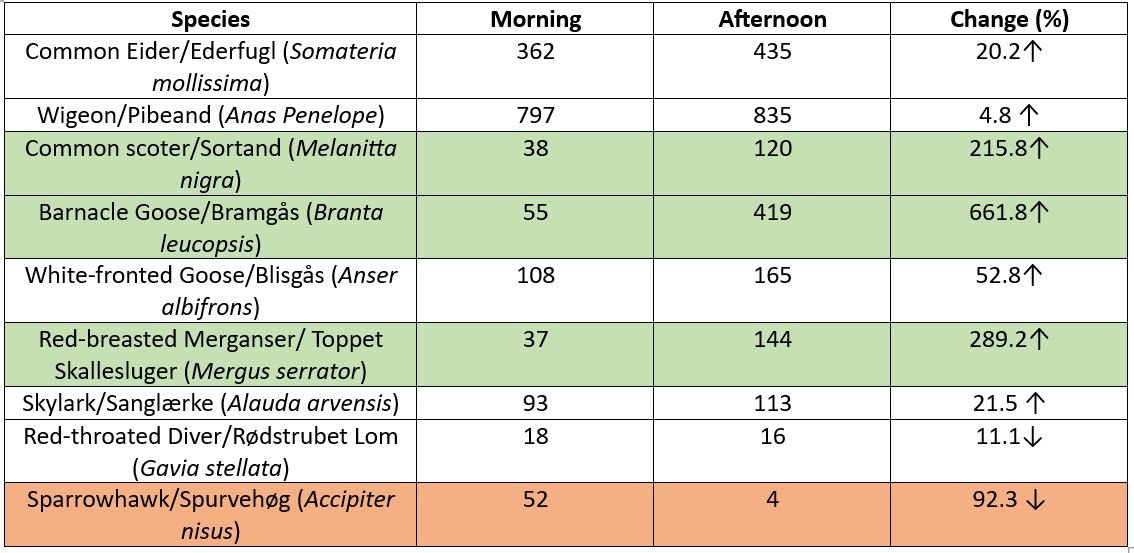
Gang i Gærdesangerne (Curruca curruca), første Rørsanger (Acrocephalus scirpaceus) og hidtil største dag i efterårssæsonen
Efter flere dage med regn og blæst var der endelig en aften og tidlig nat med klart og stille vejr i kombination med nedbør fra omkring kl. 02.00 og det var derfor med høje forventninger vi gik ud og åbnede nettene klokken halv fem. Det var således vores forventning, at det klare og stille vejr ville sætte gang i fuglene og, at nedbøren sidst på natten ville få dem til at gå ned på Gedser Fuglestation. Endeligt var den svage vind i det rigtige hjørne fra vest. Og lad det være sagt med det samme. Vi blev ikke skuffede.
De seneste dage havde Gærdesanger været en af de fugle der havde markeret sig med relativt høje tal og det kom til at holde stik med 25 Gærdesanger inden for standardtid og 29 i alt. Samtidigt fik vi årets første Rørsanger.
Rørsanger og Kærsanger (Acrocephalus palustris) ligner hinanden til forveksling og det var da også først, da vi målte længden af vingen og længden af den såkaldte ”notch” på anden svingfjer, at vi blev klar over at vi havde fanget efterårets første Rørsanger. Rørsangeren udmærkede sig således ved at have en vingelængde på kun 64 mm medens de Kærsanger vi har mærket ind til nu har haft vingelængder på knapt 70 mm og op til 74 mm.
En ”notch” er en betegnelse for en indskæring på den inderste fane af en svingfjer. Som det, måske, kan ses på billedet nedenfor har både Kærsanger og Rørsanger en indskæring på den anden svingfjer talt udefra. Når svingfjerene tælles skal man huske på, at den første svingfjer ofte er kort og ikke kan ses. Den anden svingfjer er derfor den første af de yderste synlige håndsvingfjer på billederne nedenfor. På Kærsangeren er notchen kortere end på en Rørsanger. I det skema der ses på væggen bag fuglene kan man således slå kombinationen af vingelængde og notch op og på den måde artsbestemme fuglen.
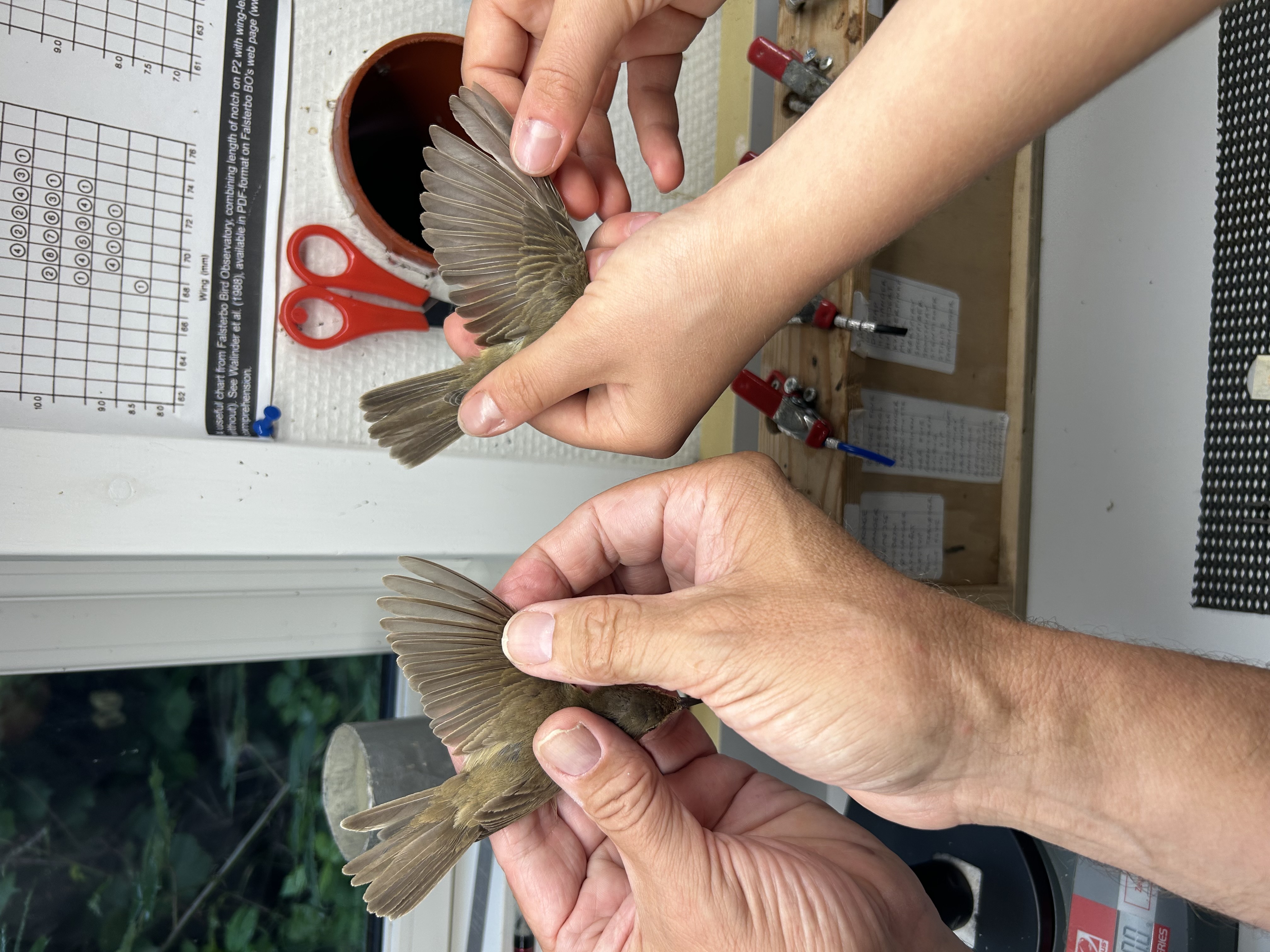
Rørsanger til venstre og Kærsanger til højre. Bemærk forskel i længde af notch og vinge.
Desuden måler vi afstanden fra næbspids til kraniet. Afstanden divideres herefter op i vingelængden. Hvis divisionen giver et relativt stort tal er det en Kærsanger og hvis det er lille en Rørsanger. Eller sagt med andre ord udtrykker forholdet at Kærsangeren er langvinget og ikke helt så fladpandet og langnæbbet som Rørsangeren. Måske kan du se, at Rørsangeren til venstre på billedet nedenfor er mere fladpandet end Kærsangeren.
Ud over mål, som er afgørende for bestemmelsen og skal tages, benytter vi os naturligvis også af helhedsindtryk og farver. Specielt på overgumpen og nederst på ryggen har Rørsanger generelt et lidt varmere rødligt skær end Kærsangeren, som har et lidt koldere grågrønligt skær. Men det er små nuancer, som ofte skal opleves flere gange før det rigtigt kan erkendes. Kan du se det rødlige skær på Rørsangeren på billedet nedenfor?
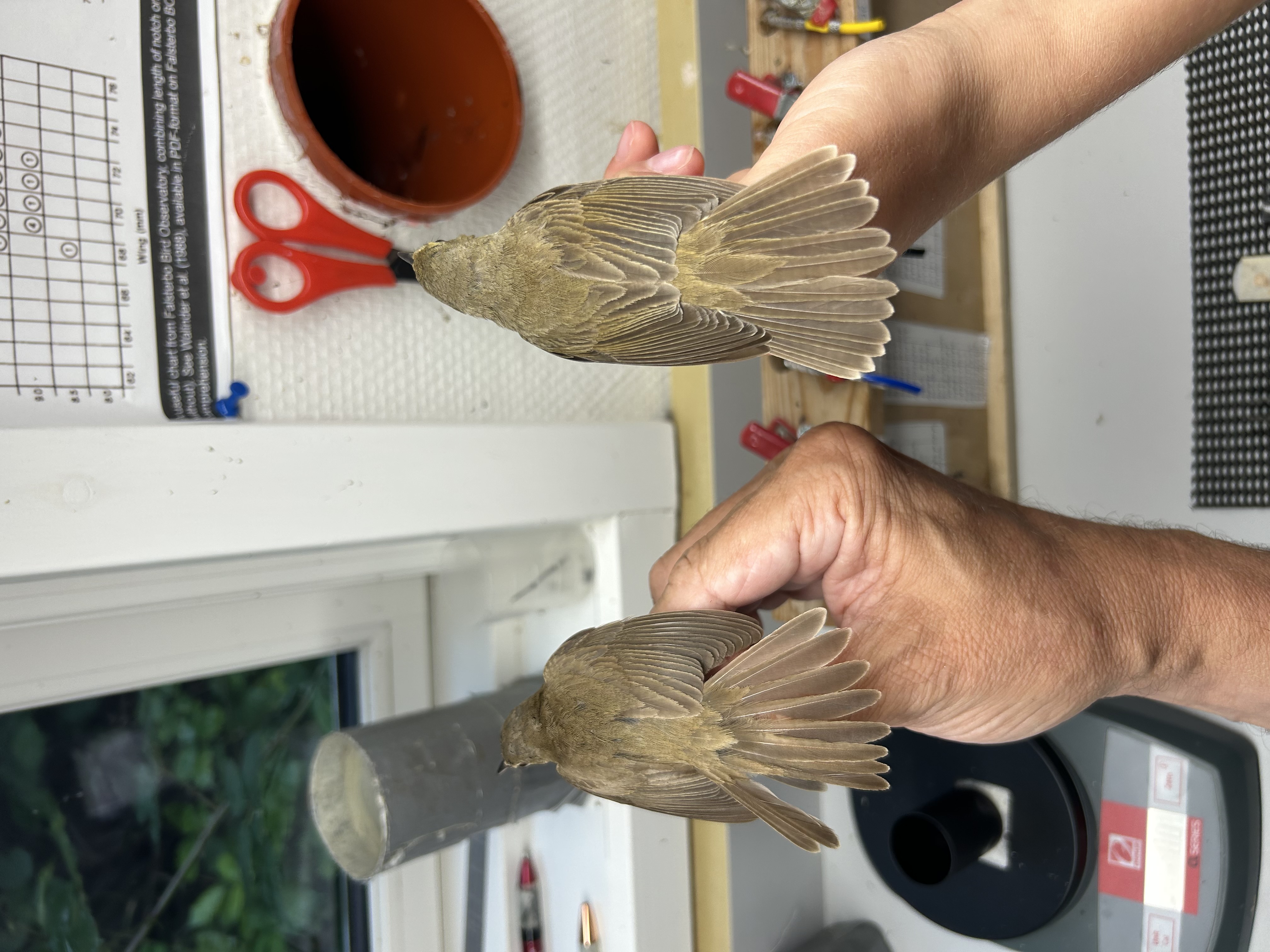
Rørsanger til venstre og Kærsanger til højre. Bemærk farvenaucer og lyse spidser på Kærsangerens svingfjer.
En karakter som ofte nævnes i den almene litteratur er at Kærsangeren har lyse spidser på svingfjerne, hvilket passer fint for de to fugle på billedet ovenfor. Endelige har Kærsanger tydeligere øjenbrynstribe end Rørsangeren, hvilket kan ses på billedet nedenfor hvor de to fugle ses face to face.
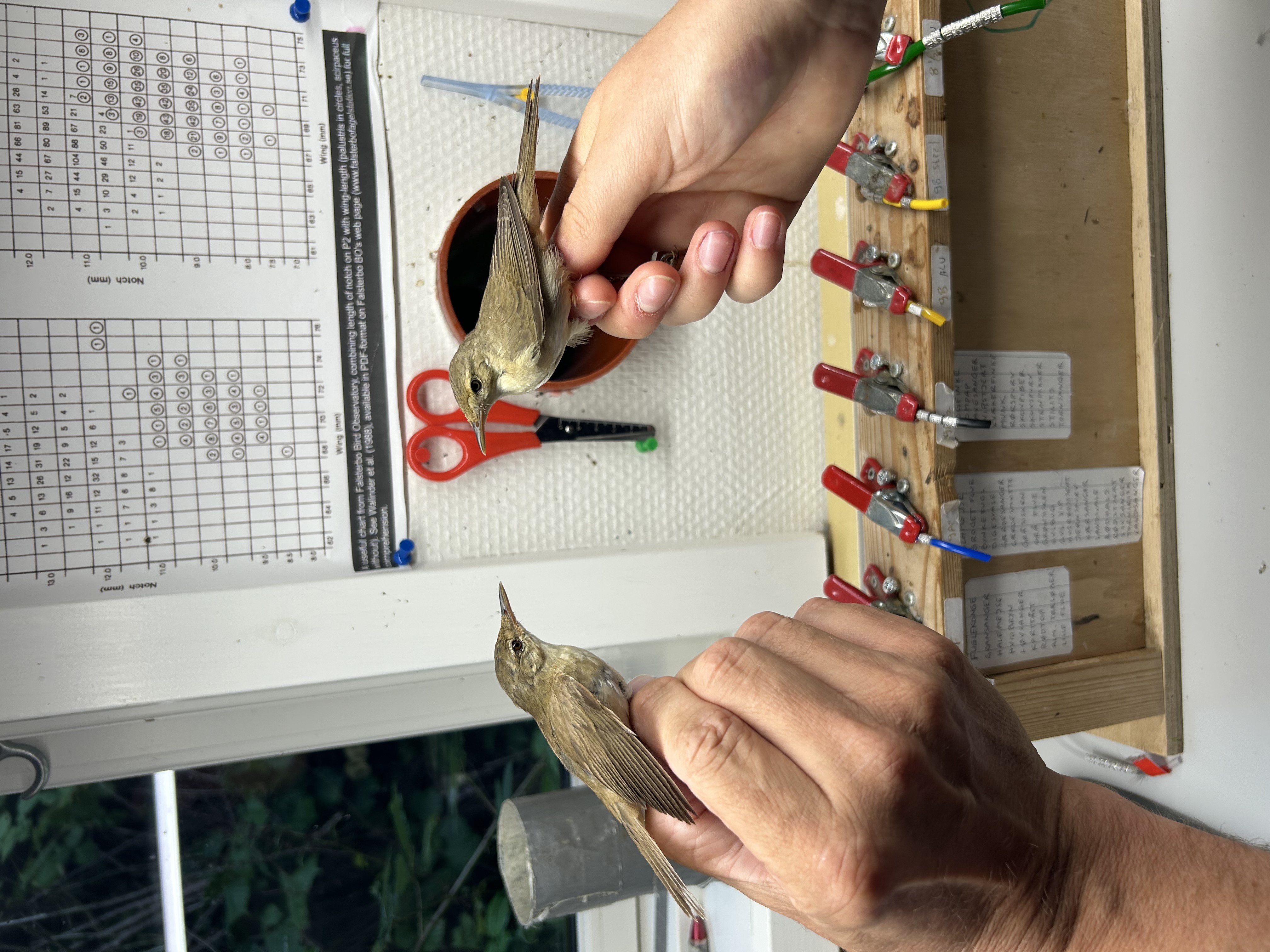
Rørsanger til venstre og Kærsanger til højre. Bemærk forskelle i øjenbrynstriben og hvor fladpandet hvovedet ser ud,
Bortset fra en times pause, på grund af regn, fortsatte Freya og Alexander med at mærke til klokke seks og blev blandt andet belønnet med en smuk Rødstjert (Phoenicurus phoenicurus) han (se foto) og sæsonens blot anden Sivsanger (Acrocephalus schoenobaenus). Så i dag har alle almindelige arter af slægten Acrocephalus været i nettene.

Rødstjert han (2k+).
Udover den megen aktivitet ved nettene fik Freya og Alexander renset to små damme op og fyldt frisk vand i. Specielt Alexander ofrede sig ved at grave bundslam væk med de bare næver. Dammene er anlagt for at tiltrække tørstige fugle til områderne omkring nettene. Så må vi se om det hjælper i de kommende dage.
I dag sagde vi farvel til Mette, som udover at deltage i ringmærkningen har gjort en stor indsats med rengøring i laboratoriet og med at trimme græskanter omkring huset. Tak for det og på gensyn på GFU.
På stationen: På stationen: Freya G. Mørup-Petersen, Alexander Brandt og Søren Mygind.
